Strategic Planning for Tourism Industry
VerifiedAdded on 2021/06/17
|18
|5407
|131
AI Summary
Contribute Materials
Your contribution can guide someone’s learning journey. Share your
documents today.
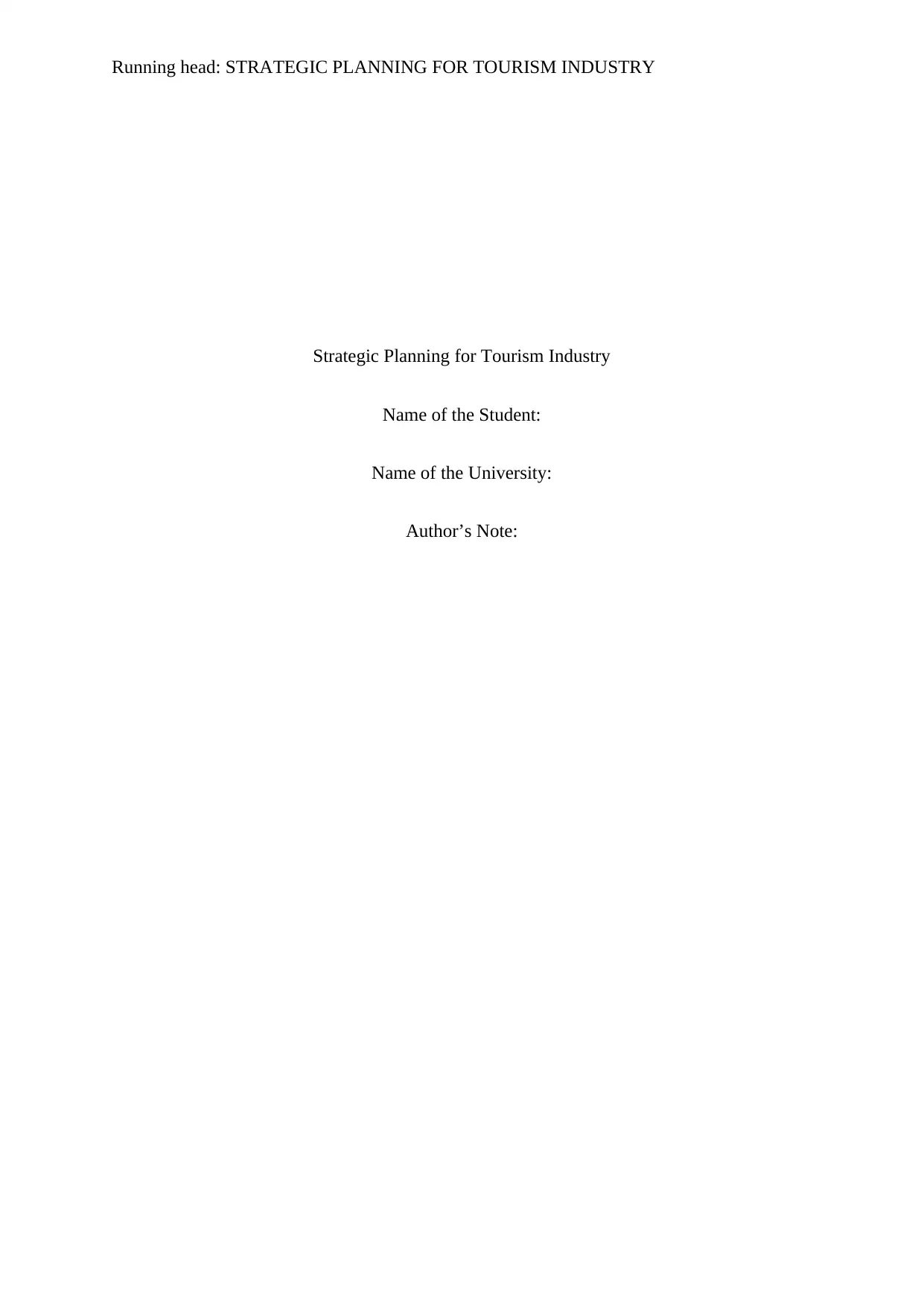
Running head: STRATEGIC PLANNING FOR TOURISM INDUSTRY
Strategic Planning for Tourism Industry
Name of the Student:
Name of the University:
Author’s Note:
Strategic Planning for Tourism Industry
Name of the Student:
Name of the University:
Author’s Note:
Secure Best Marks with AI Grader
Need help grading? Try our AI Grader for instant feedback on your assignments.
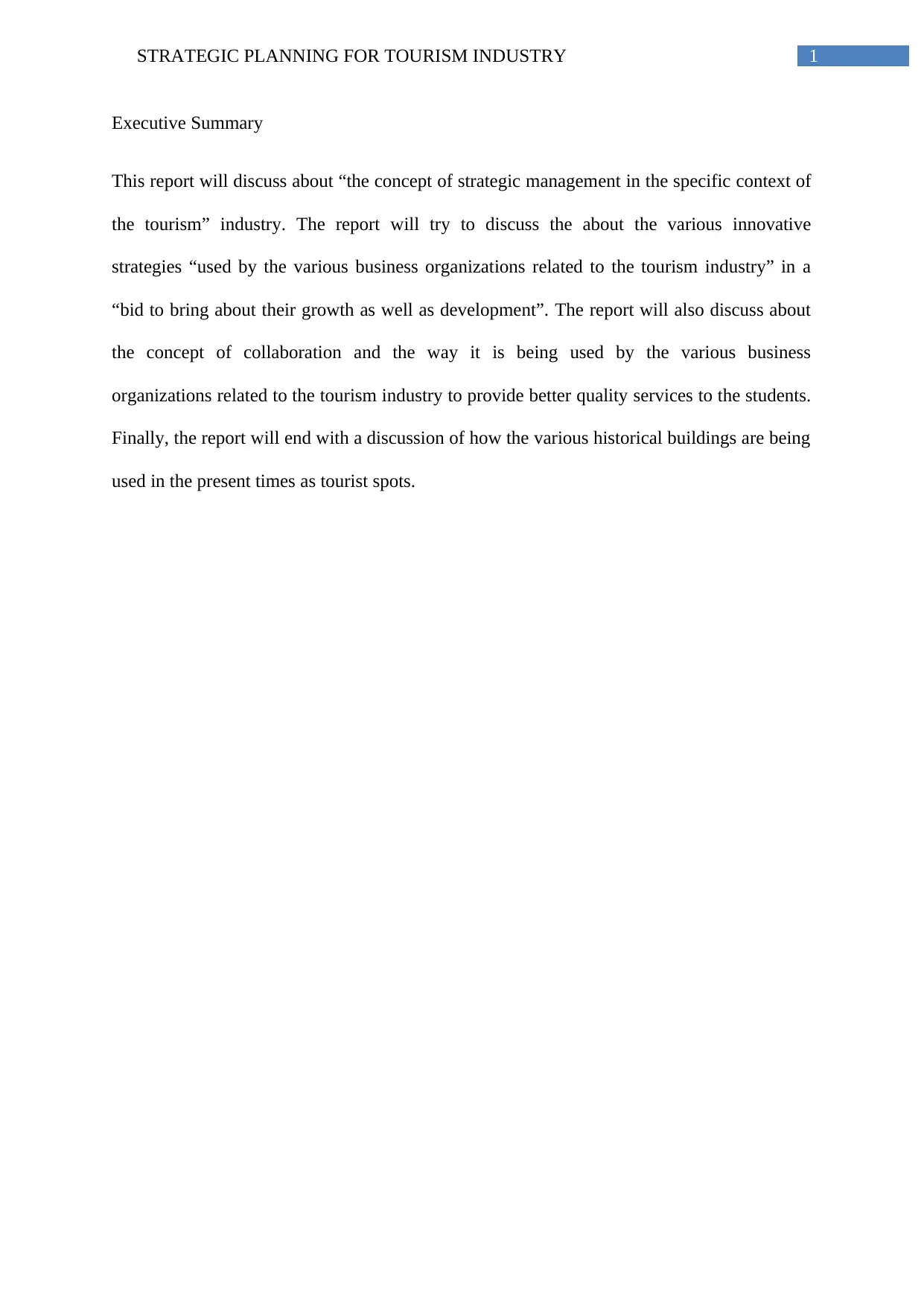
1STRATEGIC PLANNING FOR TOURISM INDUSTRY
Executive Summary
This report will discuss about “the concept of strategic management in the specific context of
the tourism” industry. The report will try to discuss the about the various innovative
strategies “used by the various business organizations related to the tourism industry” in a
“bid to bring about their growth as well as development”. The report will also discuss about
the concept of collaboration and the way it is being used by the various business
organizations related to the tourism industry to provide better quality services to the students.
Finally, the report will end with a discussion of how the various historical buildings are being
used in the present times as tourist spots.
Executive Summary
This report will discuss about “the concept of strategic management in the specific context of
the tourism” industry. The report will try to discuss the about the various innovative
strategies “used by the various business organizations related to the tourism industry” in a
“bid to bring about their growth as well as development”. The report will also discuss about
the concept of collaboration and the way it is being used by the various business
organizations related to the tourism industry to provide better quality services to the students.
Finally, the report will end with a discussion of how the various historical buildings are being
used in the present times as tourist spots.
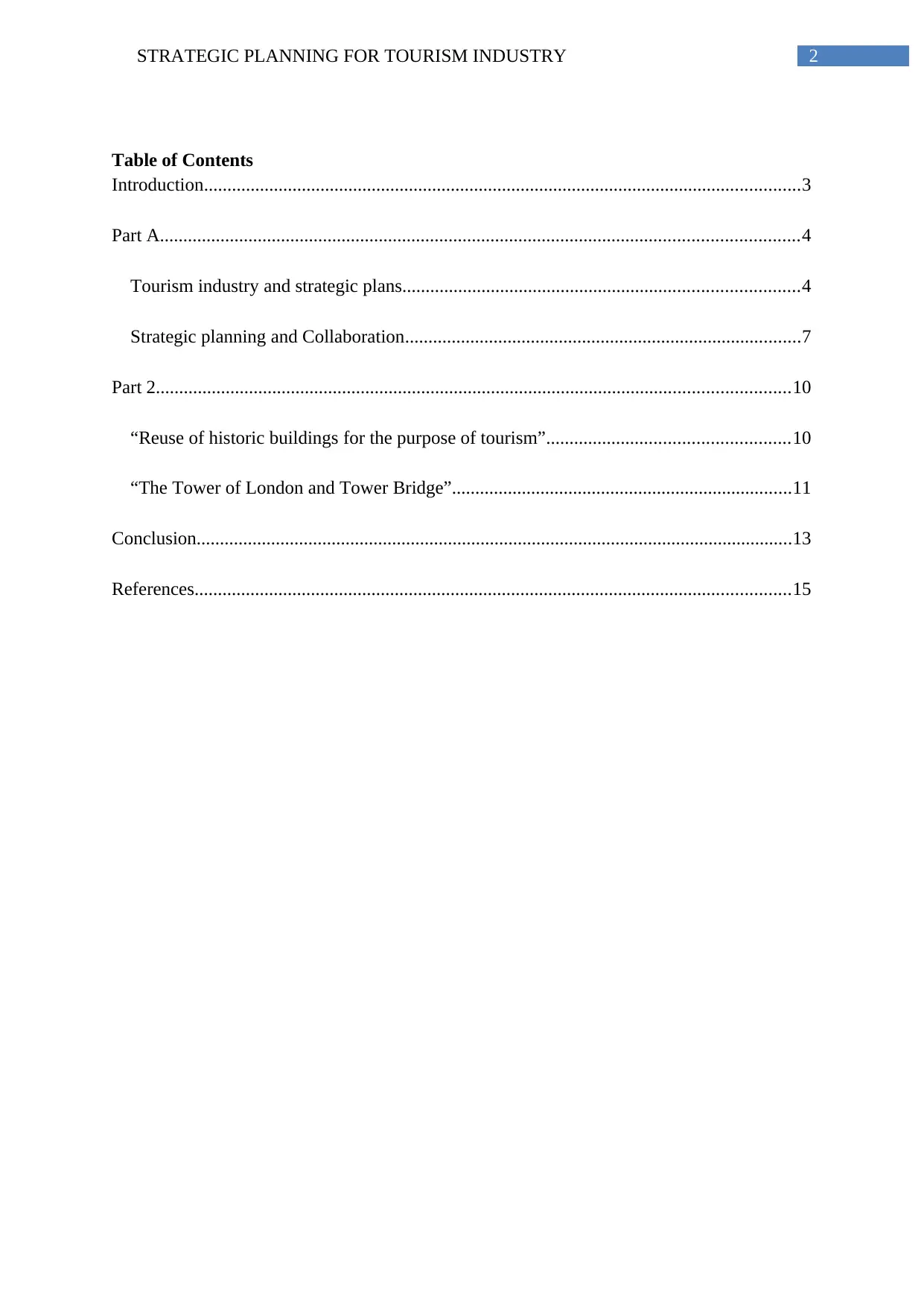
2STRATEGIC PLANNING FOR TOURISM INDUSTRY
Table of Contents
Introduction................................................................................................................................3
Part A.........................................................................................................................................4
Tourism industry and strategic plans.....................................................................................4
Strategic planning and Collaboration.....................................................................................7
Part 2........................................................................................................................................10
“Reuse of historic buildings for the purpose of tourism”....................................................10
“The Tower of London and Tower Bridge”.........................................................................11
Conclusion................................................................................................................................13
References................................................................................................................................15
Table of Contents
Introduction................................................................................................................................3
Part A.........................................................................................................................................4
Tourism industry and strategic plans.....................................................................................4
Strategic planning and Collaboration.....................................................................................7
Part 2........................................................................................................................................10
“Reuse of historic buildings for the purpose of tourism”....................................................10
“The Tower of London and Tower Bridge”.........................................................................11
Conclusion................................................................................................................................13
References................................................................................................................................15
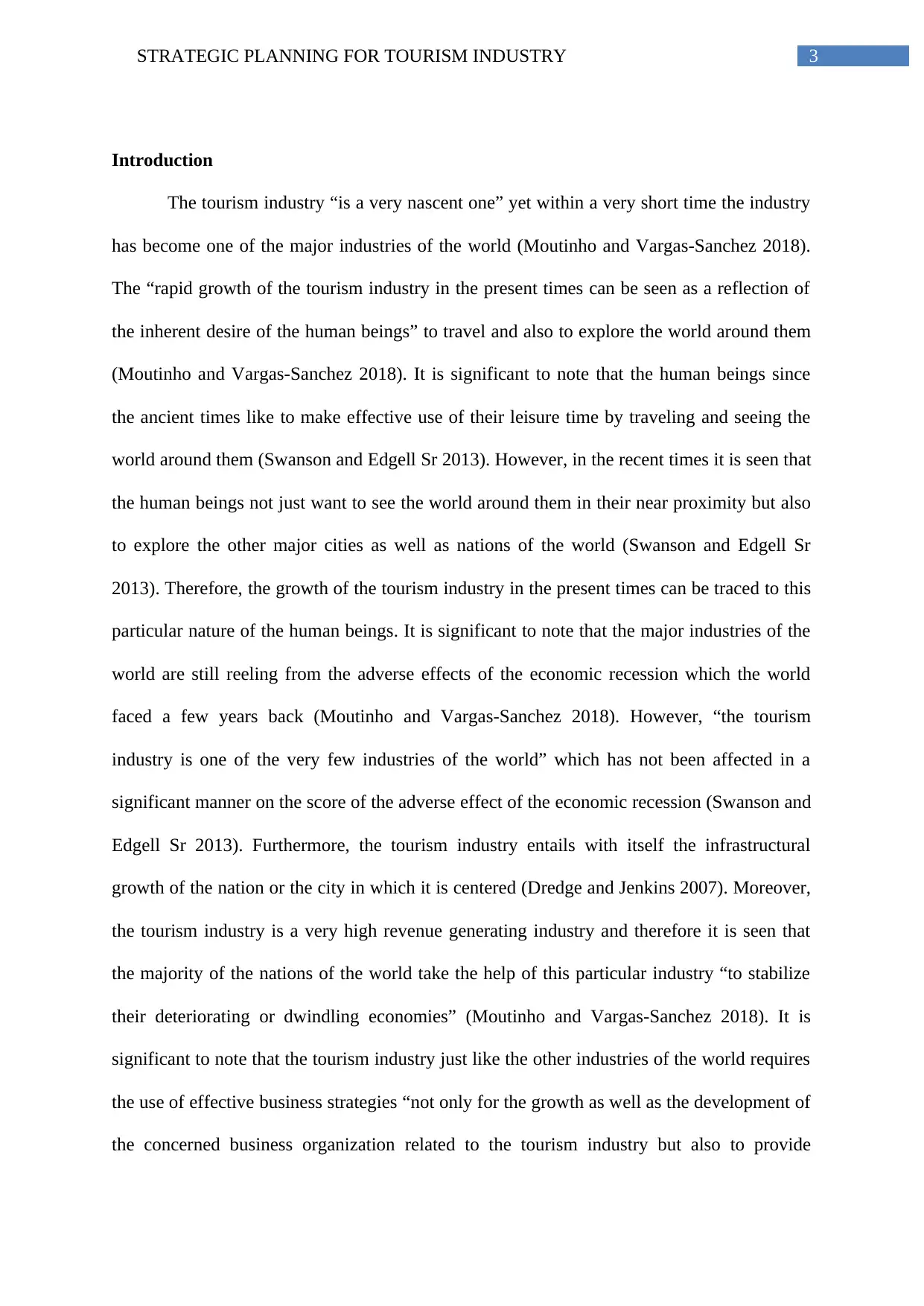
3STRATEGIC PLANNING FOR TOURISM INDUSTRY
Introduction
The tourism industry “is a very nascent one” yet within a very short time the industry
has become one of the major industries of the world (Moutinho and Vargas-Sanchez 2018).
The “rapid growth of the tourism industry in the present times can be seen as a reflection of
the inherent desire of the human beings” to travel and also to explore the world around them
(Moutinho and Vargas-Sanchez 2018). It is significant to note that the human beings since
the ancient times like to make effective use of their leisure time by traveling and seeing the
world around them (Swanson and Edgell Sr 2013). However, in the recent times it is seen that
the human beings not just want to see the world around them in their near proximity but also
to explore the other major cities as well as nations of the world (Swanson and Edgell Sr
2013). Therefore, the growth of the tourism industry in the present times can be traced to this
particular nature of the human beings. It is significant to note that the major industries of the
world are still reeling from the adverse effects of the economic recession which the world
faced a few years back (Moutinho and Vargas-Sanchez 2018). However, “the tourism
industry is one of the very few industries of the world” which has not been affected in a
significant manner on the score of the adverse effect of the economic recession (Swanson and
Edgell Sr 2013). Furthermore, the tourism industry entails with itself the infrastructural
growth of the nation or the city in which it is centered (Dredge and Jenkins 2007). Moreover,
the tourism industry is a very high revenue generating industry and therefore it is seen that
the majority of the nations of the world take the help of this particular industry “to stabilize
their deteriorating or dwindling economies” (Moutinho and Vargas-Sanchez 2018). It is
significant to note that the tourism industry just like the other industries of the world requires
the use of effective business strategies “not only for the growth as well as the development of
the concerned business organization related to the tourism industry but also to provide
Introduction
The tourism industry “is a very nascent one” yet within a very short time the industry
has become one of the major industries of the world (Moutinho and Vargas-Sanchez 2018).
The “rapid growth of the tourism industry in the present times can be seen as a reflection of
the inherent desire of the human beings” to travel and also to explore the world around them
(Moutinho and Vargas-Sanchez 2018). It is significant to note that the human beings since
the ancient times like to make effective use of their leisure time by traveling and seeing the
world around them (Swanson and Edgell Sr 2013). However, in the recent times it is seen that
the human beings not just want to see the world around them in their near proximity but also
to explore the other major cities as well as nations of the world (Swanson and Edgell Sr
2013). Therefore, the growth of the tourism industry in the present times can be traced to this
particular nature of the human beings. It is significant to note that the major industries of the
world are still reeling from the adverse effects of the economic recession which the world
faced a few years back (Moutinho and Vargas-Sanchez 2018). However, “the tourism
industry is one of the very few industries of the world” which has not been affected in a
significant manner on the score of the adverse effect of the economic recession (Swanson and
Edgell Sr 2013). Furthermore, the tourism industry entails with itself the infrastructural
growth of the nation or the city in which it is centered (Dredge and Jenkins 2007). Moreover,
the tourism industry is a very high revenue generating industry and therefore it is seen that
the majority of the nations of the world take the help of this particular industry “to stabilize
their deteriorating or dwindling economies” (Moutinho and Vargas-Sanchez 2018). It is
significant to note that the tourism industry just like the other industries of the world requires
the use of effective business strategies “not only for the growth as well as the development of
the concerned business organization related to the tourism industry but also to provide
Secure Best Marks with AI Grader
Need help grading? Try our AI Grader for instant feedback on your assignments.
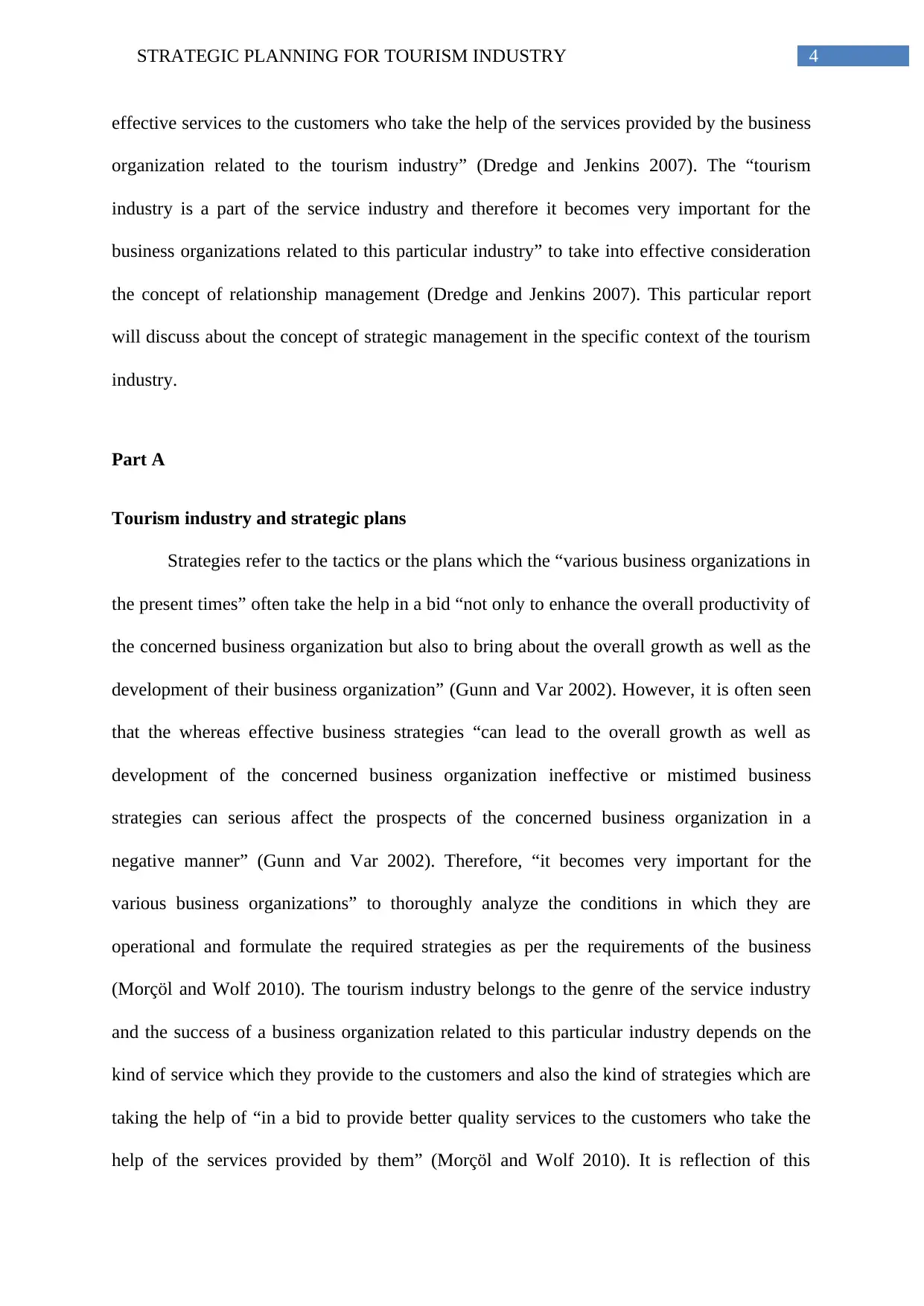
4STRATEGIC PLANNING FOR TOURISM INDUSTRY
effective services to the customers who take the help of the services provided by the business
organization related to the tourism industry” (Dredge and Jenkins 2007). The “tourism
industry is a part of the service industry and therefore it becomes very important for the
business organizations related to this particular industry” to take into effective consideration
the concept of relationship management (Dredge and Jenkins 2007). This particular report
will discuss about the concept of strategic management in the specific context of the tourism
industry.
Part A
Tourism industry and strategic plans
Strategies refer to the tactics or the plans which the “various business organizations in
the present times” often take the help in a bid “not only to enhance the overall productivity of
the concerned business organization but also to bring about the overall growth as well as the
development of their business organization” (Gunn and Var 2002). However, it is often seen
that the whereas effective business strategies “can lead to the overall growth as well as
development of the concerned business organization ineffective or mistimed business
strategies can serious affect the prospects of the concerned business organization in a
negative manner” (Gunn and Var 2002). Therefore, “it becomes very important for the
various business organizations” to thoroughly analyze the conditions in which they are
operational and formulate the required strategies as per the requirements of the business
(Morçöl and Wolf 2010). The tourism industry belongs to the genre of the service industry
and the success of a business organization related to this particular industry depends on the
kind of service which they provide to the customers and also the kind of strategies which are
taking the help of “in a bid to provide better quality services to the customers who take the
help of the services provided by them” (Morçöl and Wolf 2010). It is reflection of this
effective services to the customers who take the help of the services provided by the business
organization related to the tourism industry” (Dredge and Jenkins 2007). The “tourism
industry is a part of the service industry and therefore it becomes very important for the
business organizations related to this particular industry” to take into effective consideration
the concept of relationship management (Dredge and Jenkins 2007). This particular report
will discuss about the concept of strategic management in the specific context of the tourism
industry.
Part A
Tourism industry and strategic plans
Strategies refer to the tactics or the plans which the “various business organizations in
the present times” often take the help in a bid “not only to enhance the overall productivity of
the concerned business organization but also to bring about the overall growth as well as the
development of their business organization” (Gunn and Var 2002). However, it is often seen
that the whereas effective business strategies “can lead to the overall growth as well as
development of the concerned business organization ineffective or mistimed business
strategies can serious affect the prospects of the concerned business organization in a
negative manner” (Gunn and Var 2002). Therefore, “it becomes very important for the
various business organizations” to thoroughly analyze the conditions in which they are
operational and formulate the required strategies as per the requirements of the business
(Morçöl and Wolf 2010). The tourism industry belongs to the genre of the service industry
and the success of a business organization related to this particular industry depends on the
kind of service which they provide to the customers and also the kind of strategies which are
taking the help of “in a bid to provide better quality services to the customers who take the
help of the services provided by them” (Morçöl and Wolf 2010). It is reflection of this
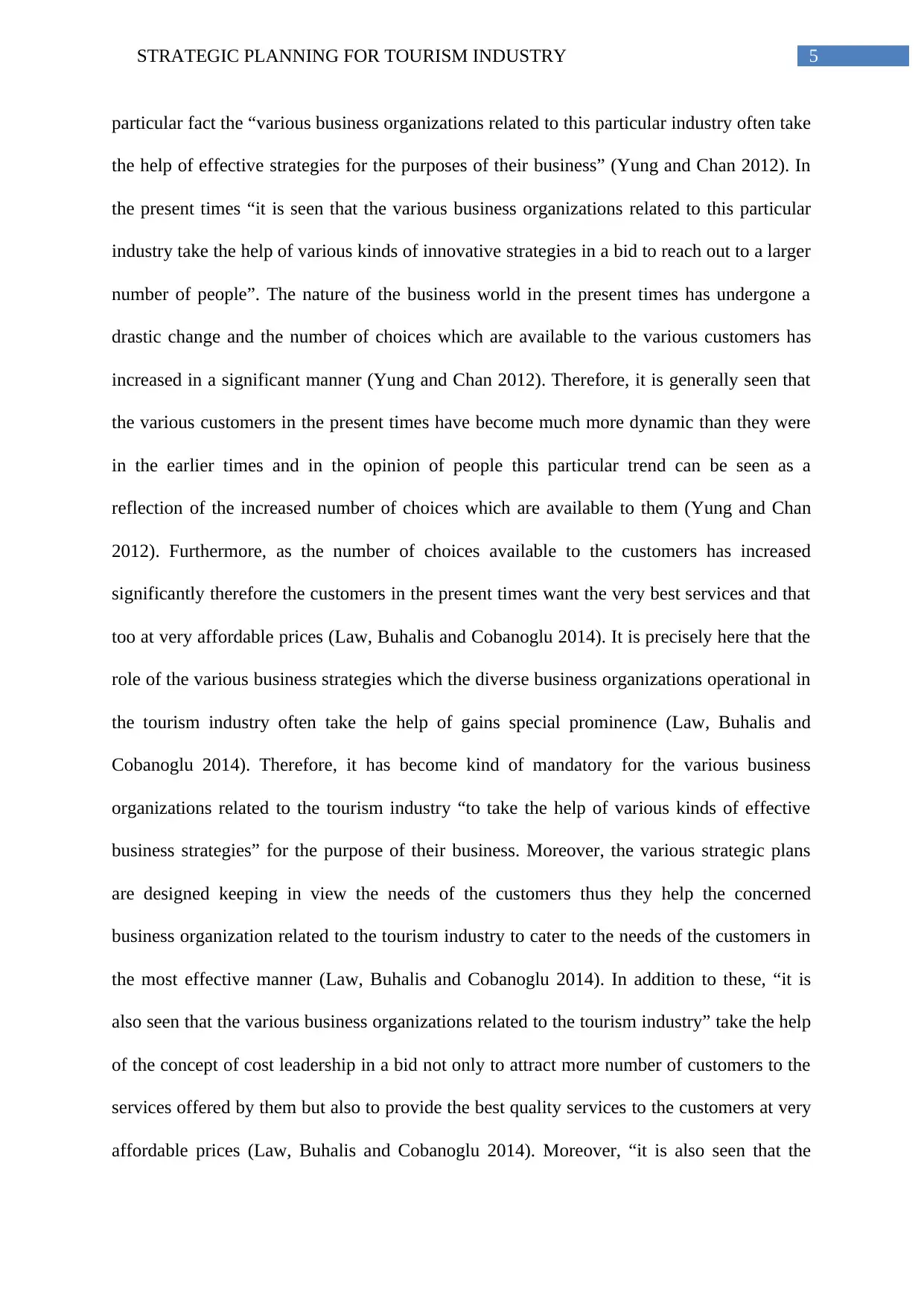
5STRATEGIC PLANNING FOR TOURISM INDUSTRY
particular fact the “various business organizations related to this particular industry often take
the help of effective strategies for the purposes of their business” (Yung and Chan 2012). In
the present times “it is seen that the various business organizations related to this particular
industry take the help of various kinds of innovative strategies in a bid to reach out to a larger
number of people”. The nature of the business world in the present times has undergone a
drastic change and the number of choices which are available to the various customers has
increased in a significant manner (Yung and Chan 2012). Therefore, it is generally seen that
the various customers in the present times have become much more dynamic than they were
in the earlier times and in the opinion of people this particular trend can be seen as a
reflection of the increased number of choices which are available to them (Yung and Chan
2012). Furthermore, as the number of choices available to the customers has increased
significantly therefore the customers in the present times want the very best services and that
too at very affordable prices (Law, Buhalis and Cobanoglu 2014). It is precisely here that the
role of the various business strategies which the diverse business organizations operational in
the tourism industry often take the help of gains special prominence (Law, Buhalis and
Cobanoglu 2014). Therefore, it has become kind of mandatory for the various business
organizations related to the tourism industry “to take the help of various kinds of effective
business strategies” for the purpose of their business. Moreover, the various strategic plans
are designed keeping in view the needs of the customers thus they help the concerned
business organization related to the tourism industry to cater to the needs of the customers in
the most effective manner (Law, Buhalis and Cobanoglu 2014). In addition to these, “it is
also seen that the various business organizations related to the tourism industry” take the help
of the concept of cost leadership in a bid not only to attract more number of customers to the
services offered by them but also to provide the best quality services to the customers at very
affordable prices (Law, Buhalis and Cobanoglu 2014). Moreover, “it is also seen that the
particular fact the “various business organizations related to this particular industry often take
the help of effective strategies for the purposes of their business” (Yung and Chan 2012). In
the present times “it is seen that the various business organizations related to this particular
industry take the help of various kinds of innovative strategies in a bid to reach out to a larger
number of people”. The nature of the business world in the present times has undergone a
drastic change and the number of choices which are available to the various customers has
increased in a significant manner (Yung and Chan 2012). Therefore, it is generally seen that
the various customers in the present times have become much more dynamic than they were
in the earlier times and in the opinion of people this particular trend can be seen as a
reflection of the increased number of choices which are available to them (Yung and Chan
2012). Furthermore, as the number of choices available to the customers has increased
significantly therefore the customers in the present times want the very best services and that
too at very affordable prices (Law, Buhalis and Cobanoglu 2014). It is precisely here that the
role of the various business strategies which the diverse business organizations operational in
the tourism industry often take the help of gains special prominence (Law, Buhalis and
Cobanoglu 2014). Therefore, it has become kind of mandatory for the various business
organizations related to the tourism industry “to take the help of various kinds of effective
business strategies” for the purpose of their business. Moreover, the various strategic plans
are designed keeping in view the needs of the customers thus they help the concerned
business organization related to the tourism industry to cater to the needs of the customers in
the most effective manner (Law, Buhalis and Cobanoglu 2014). In addition to these, “it is
also seen that the various business organizations related to the tourism industry” take the help
of the concept of cost leadership in a bid not only to attract more number of customers to the
services offered by them but also to provide the best quality services to the customers at very
affordable prices (Law, Buhalis and Cobanoglu 2014). Moreover, “it is also seen that the
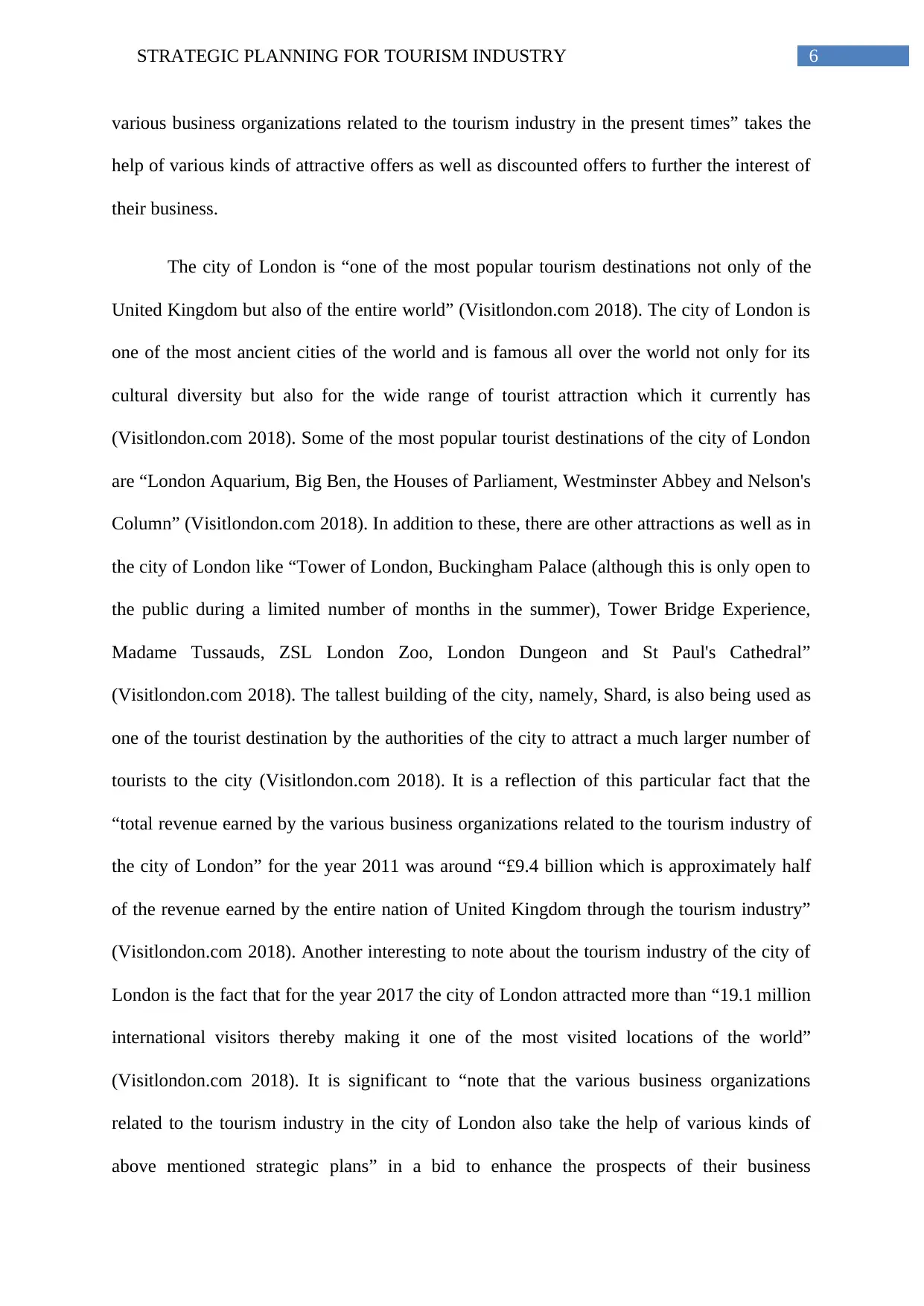
6STRATEGIC PLANNING FOR TOURISM INDUSTRY
various business organizations related to the tourism industry in the present times” takes the
help of various kinds of attractive offers as well as discounted offers to further the interest of
their business.
The city of London is “one of the most popular tourism destinations not only of the
United Kingdom but also of the entire world” (Visitlondon.com 2018). The city of London is
one of the most ancient cities of the world and is famous all over the world not only for its
cultural diversity but also for the wide range of tourist attraction which it currently has
(Visitlondon.com 2018). Some of the most popular tourist destinations of the city of London
are “London Aquarium, Big Ben, the Houses of Parliament, Westminster Abbey and Nelson's
Column” (Visitlondon.com 2018). In addition to these, there are other attractions as well as in
the city of London like “Tower of London, Buckingham Palace (although this is only open to
the public during a limited number of months in the summer), Tower Bridge Experience,
Madame Tussauds, ZSL London Zoo, London Dungeon and St Paul's Cathedral”
(Visitlondon.com 2018). The tallest building of the city, namely, Shard, is also being used as
one of the tourist destination by the authorities of the city to attract a much larger number of
tourists to the city (Visitlondon.com 2018). It is a reflection of this particular fact that the
“total revenue earned by the various business organizations related to the tourism industry of
the city of London” for the year 2011 was around “£9.4 billion which is approximately half
of the revenue earned by the entire nation of United Kingdom through the tourism industry”
(Visitlondon.com 2018). Another interesting to note about the tourism industry of the city of
London is the fact that for the year 2017 the city of London attracted more than “19.1 million
international visitors thereby making it one of the most visited locations of the world”
(Visitlondon.com 2018). It is significant to “note that the various business organizations
related to the tourism industry in the city of London also take the help of various kinds of
above mentioned strategic plans” in a bid to enhance the prospects of their business
various business organizations related to the tourism industry in the present times” takes the
help of various kinds of attractive offers as well as discounted offers to further the interest of
their business.
The city of London is “one of the most popular tourism destinations not only of the
United Kingdom but also of the entire world” (Visitlondon.com 2018). The city of London is
one of the most ancient cities of the world and is famous all over the world not only for its
cultural diversity but also for the wide range of tourist attraction which it currently has
(Visitlondon.com 2018). Some of the most popular tourist destinations of the city of London
are “London Aquarium, Big Ben, the Houses of Parliament, Westminster Abbey and Nelson's
Column” (Visitlondon.com 2018). In addition to these, there are other attractions as well as in
the city of London like “Tower of London, Buckingham Palace (although this is only open to
the public during a limited number of months in the summer), Tower Bridge Experience,
Madame Tussauds, ZSL London Zoo, London Dungeon and St Paul's Cathedral”
(Visitlondon.com 2018). The tallest building of the city, namely, Shard, is also being used as
one of the tourist destination by the authorities of the city to attract a much larger number of
tourists to the city (Visitlondon.com 2018). It is a reflection of this particular fact that the
“total revenue earned by the various business organizations related to the tourism industry of
the city of London” for the year 2011 was around “£9.4 billion which is approximately half
of the revenue earned by the entire nation of United Kingdom through the tourism industry”
(Visitlondon.com 2018). Another interesting to note about the tourism industry of the city of
London is the fact that for the year 2017 the city of London attracted more than “19.1 million
international visitors thereby making it one of the most visited locations of the world”
(Visitlondon.com 2018). It is significant to “note that the various business organizations
related to the tourism industry in the city of London also take the help of various kinds of
above mentioned strategic plans” in a bid to enhance the prospects of their business
Paraphrase This Document
Need a fresh take? Get an instant paraphrase of this document with our AI Paraphraser
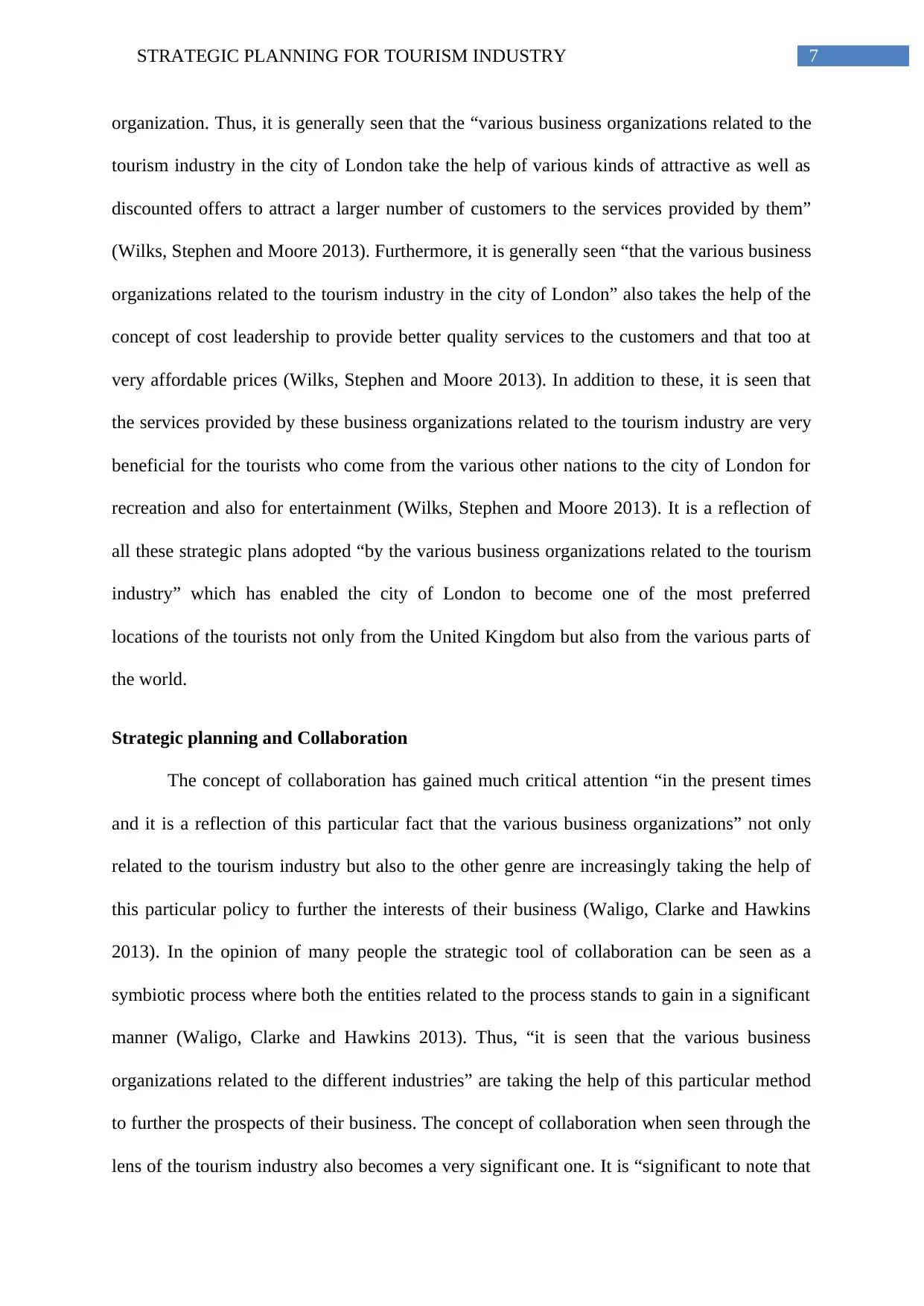
7STRATEGIC PLANNING FOR TOURISM INDUSTRY
organization. Thus, it is generally seen that the “various business organizations related to the
tourism industry in the city of London take the help of various kinds of attractive as well as
discounted offers to attract a larger number of customers to the services provided by them”
(Wilks, Stephen and Moore 2013). Furthermore, it is generally seen “that the various business
organizations related to the tourism industry in the city of London” also takes the help of the
concept of cost leadership to provide better quality services to the customers and that too at
very affordable prices (Wilks, Stephen and Moore 2013). In addition to these, it is seen that
the services provided by these business organizations related to the tourism industry are very
beneficial for the tourists who come from the various other nations to the city of London for
recreation and also for entertainment (Wilks, Stephen and Moore 2013). It is a reflection of
all these strategic plans adopted “by the various business organizations related to the tourism
industry” which has enabled the city of London to become one of the most preferred
locations of the tourists not only from the United Kingdom but also from the various parts of
the world.
Strategic planning and Collaboration
The concept of collaboration has gained much critical attention “in the present times
and it is a reflection of this particular fact that the various business organizations” not only
related to the tourism industry but also to the other genre are increasingly taking the help of
this particular policy to further the interests of their business (Waligo, Clarke and Hawkins
2013). In the opinion of many people the strategic tool of collaboration can be seen as a
symbiotic process where both the entities related to the process stands to gain in a significant
manner (Waligo, Clarke and Hawkins 2013). Thus, “it is seen that the various business
organizations related to the different industries” are taking the help of this particular method
to further the prospects of their business. The concept of collaboration when seen through the
lens of the tourism industry also becomes a very significant one. It is “significant to note that
organization. Thus, it is generally seen that the “various business organizations related to the
tourism industry in the city of London take the help of various kinds of attractive as well as
discounted offers to attract a larger number of customers to the services provided by them”
(Wilks, Stephen and Moore 2013). Furthermore, it is generally seen “that the various business
organizations related to the tourism industry in the city of London” also takes the help of the
concept of cost leadership to provide better quality services to the customers and that too at
very affordable prices (Wilks, Stephen and Moore 2013). In addition to these, it is seen that
the services provided by these business organizations related to the tourism industry are very
beneficial for the tourists who come from the various other nations to the city of London for
recreation and also for entertainment (Wilks, Stephen and Moore 2013). It is a reflection of
all these strategic plans adopted “by the various business organizations related to the tourism
industry” which has enabled the city of London to become one of the most preferred
locations of the tourists not only from the United Kingdom but also from the various parts of
the world.
Strategic planning and Collaboration
The concept of collaboration has gained much critical attention “in the present times
and it is a reflection of this particular fact that the various business organizations” not only
related to the tourism industry but also to the other genre are increasingly taking the help of
this particular policy to further the interests of their business (Waligo, Clarke and Hawkins
2013). In the opinion of many people the strategic tool of collaboration can be seen as a
symbiotic process where both the entities related to the process stands to gain in a significant
manner (Waligo, Clarke and Hawkins 2013). Thus, “it is seen that the various business
organizations related to the different industries” are taking the help of this particular method
to further the prospects of their business. The concept of collaboration when seen through the
lens of the tourism industry also becomes a very significant one. It is “significant to note that
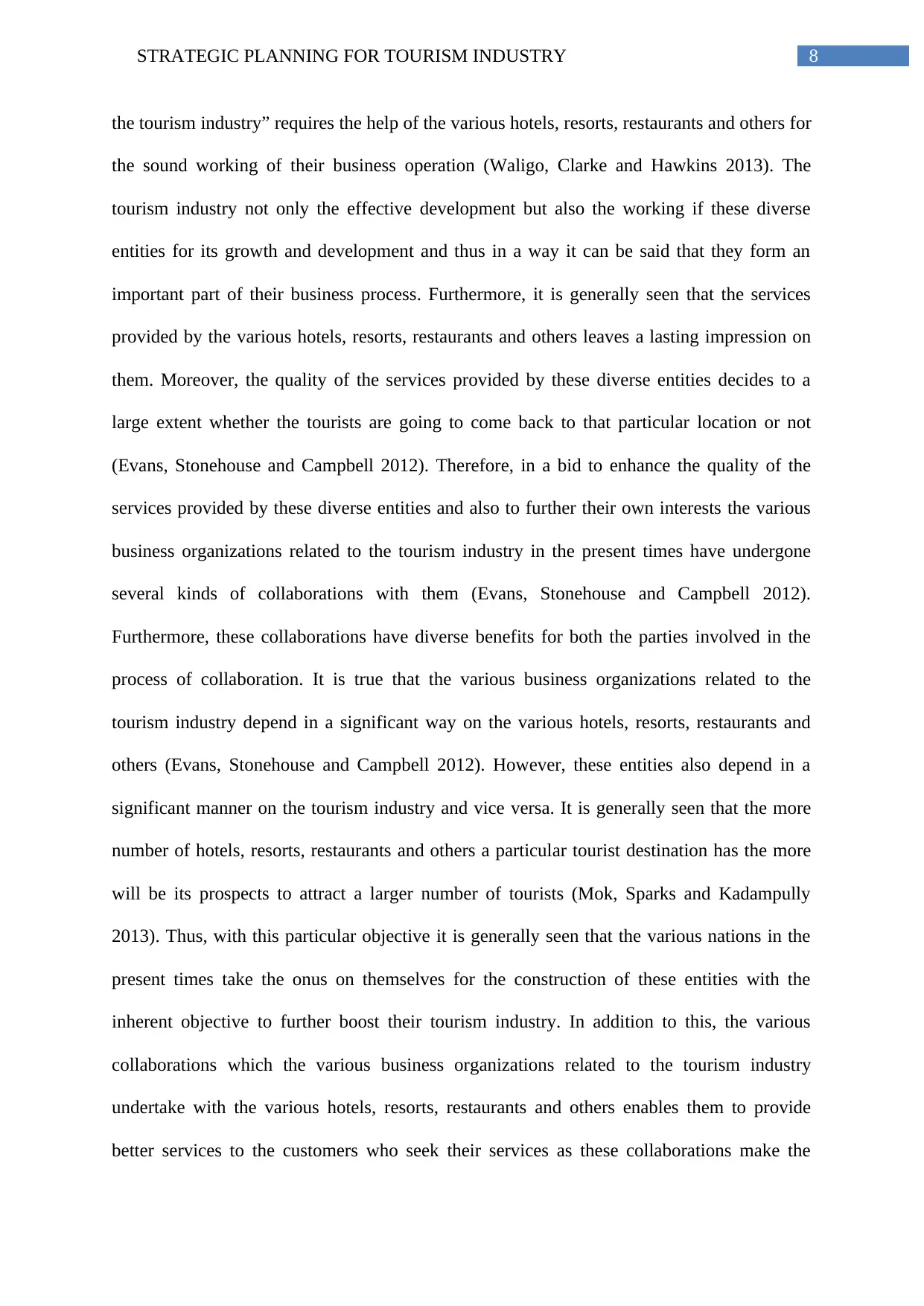
8STRATEGIC PLANNING FOR TOURISM INDUSTRY
the tourism industry” requires the help of the various hotels, resorts, restaurants and others for
the sound working of their business operation (Waligo, Clarke and Hawkins 2013). The
tourism industry not only the effective development but also the working if these diverse
entities for its growth and development and thus in a way it can be said that they form an
important part of their business process. Furthermore, it is generally seen that the services
provided by the various hotels, resorts, restaurants and others leaves a lasting impression on
them. Moreover, the quality of the services provided by these diverse entities decides to a
large extent whether the tourists are going to come back to that particular location or not
(Evans, Stonehouse and Campbell 2012). Therefore, in a bid to enhance the quality of the
services provided by these diverse entities and also to further their own interests the various
business organizations related to the tourism industry in the present times have undergone
several kinds of collaborations with them (Evans, Stonehouse and Campbell 2012).
Furthermore, these collaborations have diverse benefits for both the parties involved in the
process of collaboration. It is true that the various business organizations related to the
tourism industry depend in a significant way on the various hotels, resorts, restaurants and
others (Evans, Stonehouse and Campbell 2012). However, these entities also depend in a
significant manner on the tourism industry and vice versa. It is generally seen that the more
number of hotels, resorts, restaurants and others a particular tourist destination has the more
will be its prospects to attract a larger number of tourists (Mok, Sparks and Kadampully
2013). Thus, with this particular objective it is generally seen that the various nations in the
present times take the onus on themselves for the construction of these entities with the
inherent objective to further boost their tourism industry. In addition to this, the various
collaborations which the various business organizations related to the tourism industry
undertake with the various hotels, resorts, restaurants and others enables them to provide
better services to the customers who seek their services as these collaborations make the
the tourism industry” requires the help of the various hotels, resorts, restaurants and others for
the sound working of their business operation (Waligo, Clarke and Hawkins 2013). The
tourism industry not only the effective development but also the working if these diverse
entities for its growth and development and thus in a way it can be said that they form an
important part of their business process. Furthermore, it is generally seen that the services
provided by the various hotels, resorts, restaurants and others leaves a lasting impression on
them. Moreover, the quality of the services provided by these diverse entities decides to a
large extent whether the tourists are going to come back to that particular location or not
(Evans, Stonehouse and Campbell 2012). Therefore, in a bid to enhance the quality of the
services provided by these diverse entities and also to further their own interests the various
business organizations related to the tourism industry in the present times have undergone
several kinds of collaborations with them (Evans, Stonehouse and Campbell 2012).
Furthermore, these collaborations have diverse benefits for both the parties involved in the
process of collaboration. It is true that the various business organizations related to the
tourism industry depend in a significant way on the various hotels, resorts, restaurants and
others (Evans, Stonehouse and Campbell 2012). However, these entities also depend in a
significant manner on the tourism industry and vice versa. It is generally seen that the more
number of hotels, resorts, restaurants and others a particular tourist destination has the more
will be its prospects to attract a larger number of tourists (Mok, Sparks and Kadampully
2013). Thus, with this particular objective it is generally seen that the various nations in the
present times take the onus on themselves for the construction of these entities with the
inherent objective to further boost their tourism industry. In addition to this, the various
collaborations which the various business organizations related to the tourism industry
undertake with the various hotels, resorts, restaurants and others enables them to provide
better services to the customers who seek their services as these collaborations make the
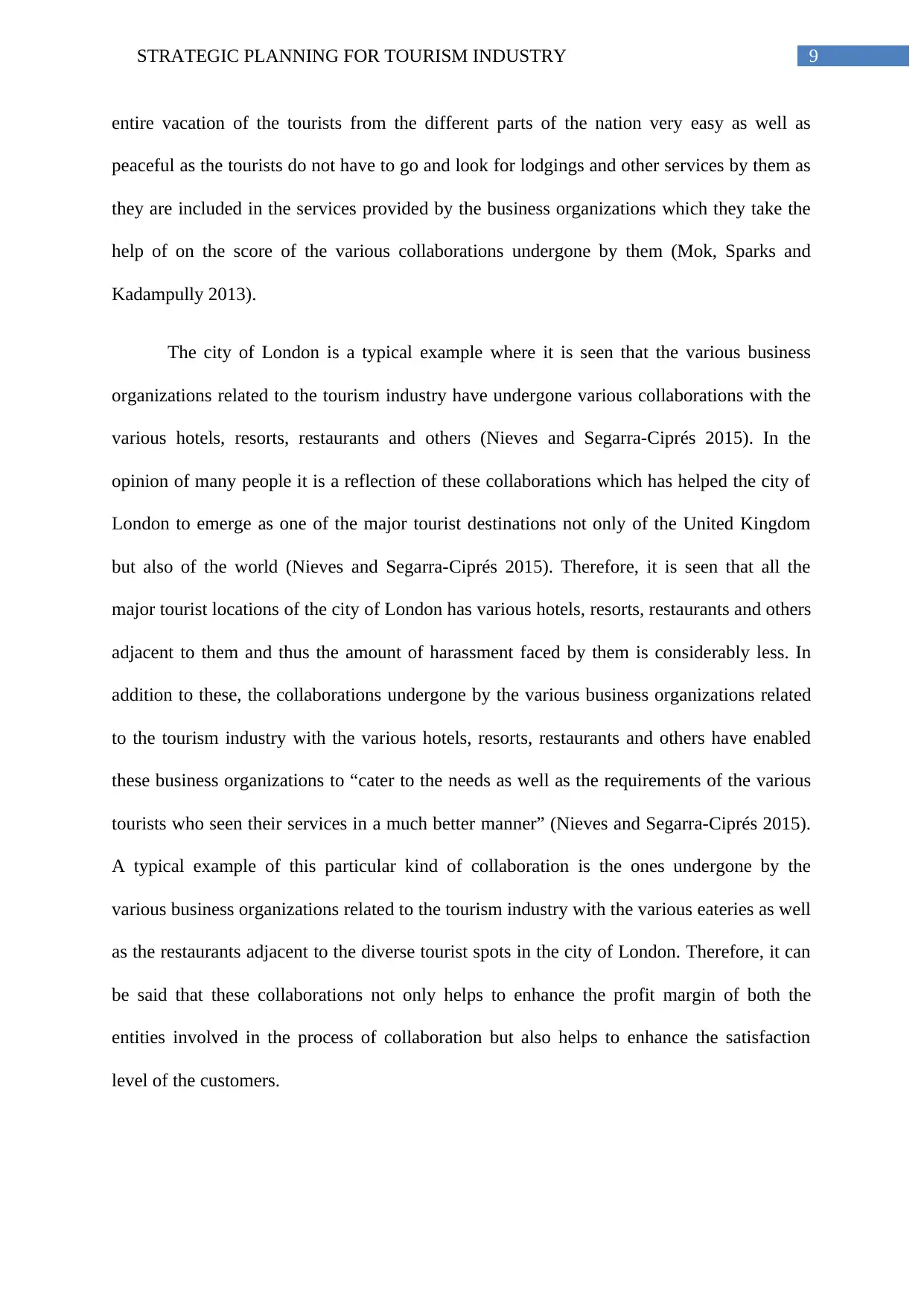
9STRATEGIC PLANNING FOR TOURISM INDUSTRY
entire vacation of the tourists from the different parts of the nation very easy as well as
peaceful as the tourists do not have to go and look for lodgings and other services by them as
they are included in the services provided by the business organizations which they take the
help of on the score of the various collaborations undergone by them (Mok, Sparks and
Kadampully 2013).
The city of London is a typical example where it is seen that the various business
organizations related to the tourism industry have undergone various collaborations with the
various hotels, resorts, restaurants and others (Nieves and Segarra-Ciprés 2015). In the
opinion of many people it is a reflection of these collaborations which has helped the city of
London to emerge as one of the major tourist destinations not only of the United Kingdom
but also of the world (Nieves and Segarra-Ciprés 2015). Therefore, it is seen that all the
major tourist locations of the city of London has various hotels, resorts, restaurants and others
adjacent to them and thus the amount of harassment faced by them is considerably less. In
addition to these, the collaborations undergone by the various business organizations related
to the tourism industry with the various hotels, resorts, restaurants and others have enabled
these business organizations to “cater to the needs as well as the requirements of the various
tourists who seen their services in a much better manner” (Nieves and Segarra-Ciprés 2015).
A typical example of this particular kind of collaboration is the ones undergone by the
various business organizations related to the tourism industry with the various eateries as well
as the restaurants adjacent to the diverse tourist spots in the city of London. Therefore, it can
be said that these collaborations not only helps to enhance the profit margin of both the
entities involved in the process of collaboration but also helps to enhance the satisfaction
level of the customers.
entire vacation of the tourists from the different parts of the nation very easy as well as
peaceful as the tourists do not have to go and look for lodgings and other services by them as
they are included in the services provided by the business organizations which they take the
help of on the score of the various collaborations undergone by them (Mok, Sparks and
Kadampully 2013).
The city of London is a typical example where it is seen that the various business
organizations related to the tourism industry have undergone various collaborations with the
various hotels, resorts, restaurants and others (Nieves and Segarra-Ciprés 2015). In the
opinion of many people it is a reflection of these collaborations which has helped the city of
London to emerge as one of the major tourist destinations not only of the United Kingdom
but also of the world (Nieves and Segarra-Ciprés 2015). Therefore, it is seen that all the
major tourist locations of the city of London has various hotels, resorts, restaurants and others
adjacent to them and thus the amount of harassment faced by them is considerably less. In
addition to these, the collaborations undergone by the various business organizations related
to the tourism industry with the various hotels, resorts, restaurants and others have enabled
these business organizations to “cater to the needs as well as the requirements of the various
tourists who seen their services in a much better manner” (Nieves and Segarra-Ciprés 2015).
A typical example of this particular kind of collaboration is the ones undergone by the
various business organizations related to the tourism industry with the various eateries as well
as the restaurants adjacent to the diverse tourist spots in the city of London. Therefore, it can
be said that these collaborations not only helps to enhance the profit margin of both the
entities involved in the process of collaboration but also helps to enhance the satisfaction
level of the customers.
Secure Best Marks with AI Grader
Need help grading? Try our AI Grader for instant feedback on your assignments.
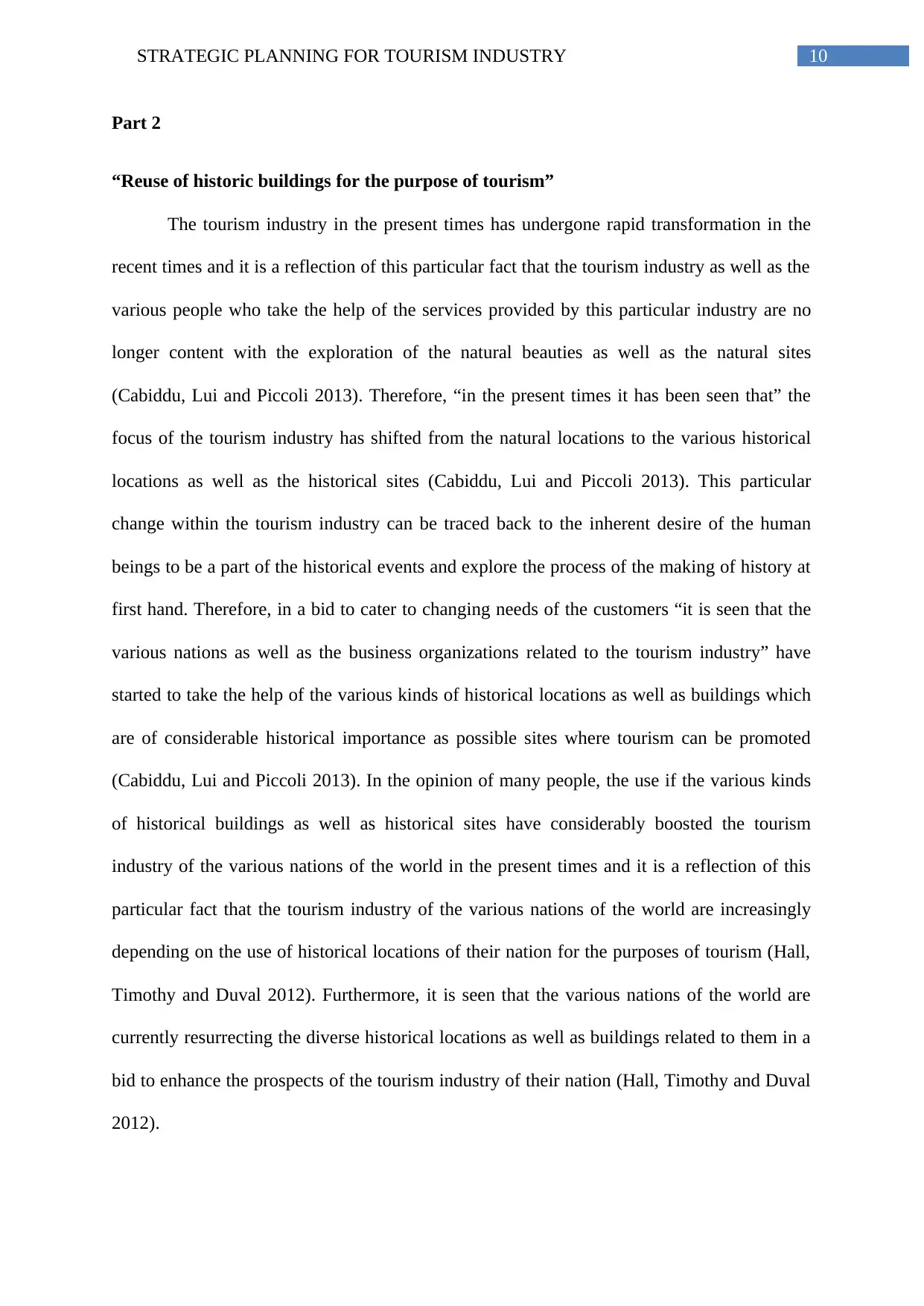
10STRATEGIC PLANNING FOR TOURISM INDUSTRY
Part 2
“Reuse of historic buildings for the purpose of tourism”
The tourism industry in the present times has undergone rapid transformation in the
recent times and it is a reflection of this particular fact that the tourism industry as well as the
various people who take the help of the services provided by this particular industry are no
longer content with the exploration of the natural beauties as well as the natural sites
(Cabiddu, Lui and Piccoli 2013). Therefore, “in the present times it has been seen that” the
focus of the tourism industry has shifted from the natural locations to the various historical
locations as well as the historical sites (Cabiddu, Lui and Piccoli 2013). This particular
change within the tourism industry can be traced back to the inherent desire of the human
beings to be a part of the historical events and explore the process of the making of history at
first hand. Therefore, in a bid to cater to changing needs of the customers “it is seen that the
various nations as well as the business organizations related to the tourism industry” have
started to take the help of the various kinds of historical locations as well as buildings which
are of considerable historical importance as possible sites where tourism can be promoted
(Cabiddu, Lui and Piccoli 2013). In the opinion of many people, the use if the various kinds
of historical buildings as well as historical sites have considerably boosted the tourism
industry of the various nations of the world in the present times and it is a reflection of this
particular fact that the tourism industry of the various nations of the world are increasingly
depending on the use of historical locations of their nation for the purposes of tourism (Hall,
Timothy and Duval 2012). Furthermore, it is seen that the various nations of the world are
currently resurrecting the diverse historical locations as well as buildings related to them in a
bid to enhance the prospects of the tourism industry of their nation (Hall, Timothy and Duval
2012).
Part 2
“Reuse of historic buildings for the purpose of tourism”
The tourism industry in the present times has undergone rapid transformation in the
recent times and it is a reflection of this particular fact that the tourism industry as well as the
various people who take the help of the services provided by this particular industry are no
longer content with the exploration of the natural beauties as well as the natural sites
(Cabiddu, Lui and Piccoli 2013). Therefore, “in the present times it has been seen that” the
focus of the tourism industry has shifted from the natural locations to the various historical
locations as well as the historical sites (Cabiddu, Lui and Piccoli 2013). This particular
change within the tourism industry can be traced back to the inherent desire of the human
beings to be a part of the historical events and explore the process of the making of history at
first hand. Therefore, in a bid to cater to changing needs of the customers “it is seen that the
various nations as well as the business organizations related to the tourism industry” have
started to take the help of the various kinds of historical locations as well as buildings which
are of considerable historical importance as possible sites where tourism can be promoted
(Cabiddu, Lui and Piccoli 2013). In the opinion of many people, the use if the various kinds
of historical buildings as well as historical sites have considerably boosted the tourism
industry of the various nations of the world in the present times and it is a reflection of this
particular fact that the tourism industry of the various nations of the world are increasingly
depending on the use of historical locations of their nation for the purposes of tourism (Hall,
Timothy and Duval 2012). Furthermore, it is seen that the various nations of the world are
currently resurrecting the diverse historical locations as well as buildings related to them in a
bid to enhance the prospects of the tourism industry of their nation (Hall, Timothy and Duval
2012).
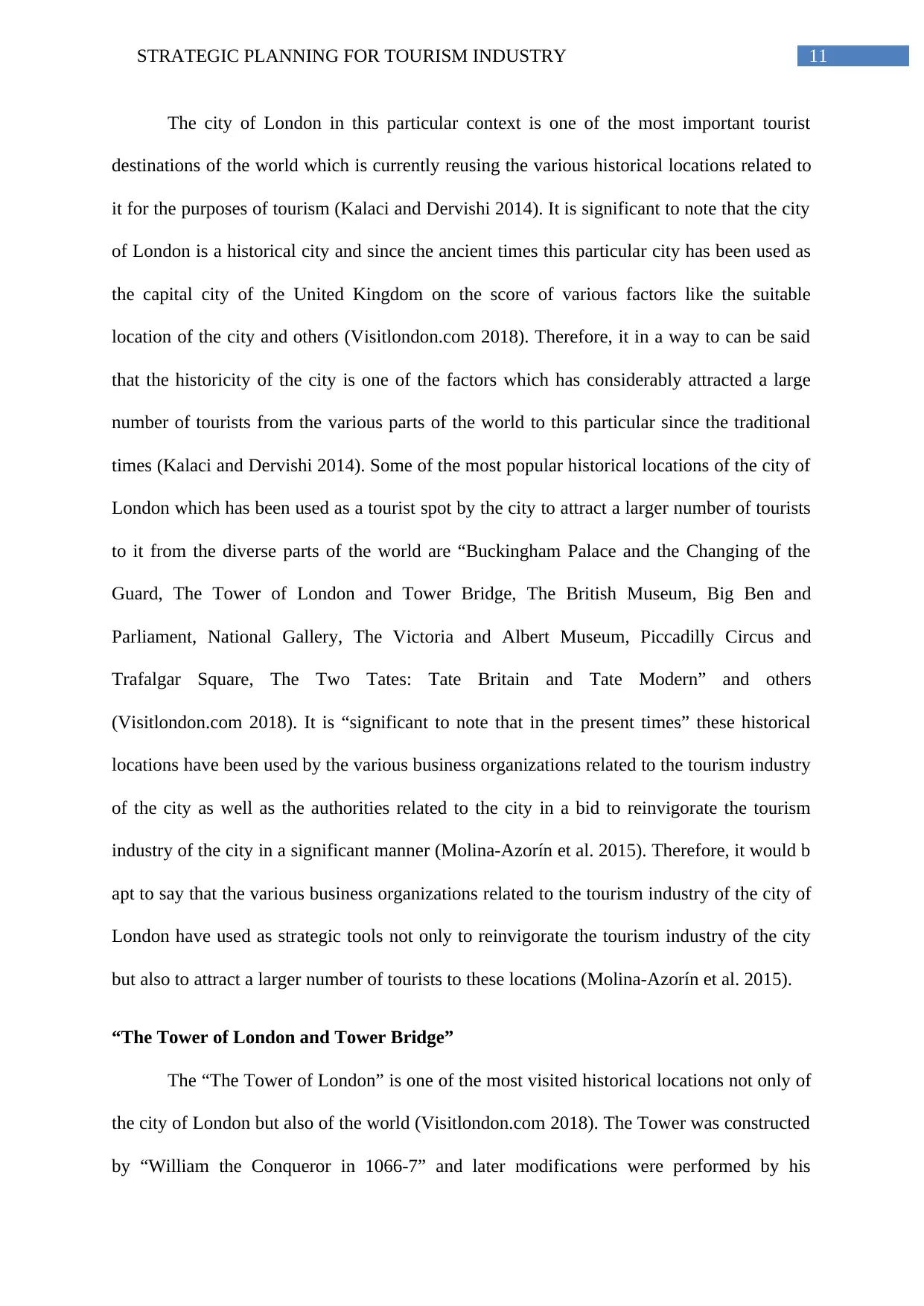
11STRATEGIC PLANNING FOR TOURISM INDUSTRY
The city of London in this particular context is one of the most important tourist
destinations of the world which is currently reusing the various historical locations related to
it for the purposes of tourism (Kalaci and Dervishi 2014). It is significant to note that the city
of London is a historical city and since the ancient times this particular city has been used as
the capital city of the United Kingdom on the score of various factors like the suitable
location of the city and others (Visitlondon.com 2018). Therefore, it in a way to can be said
that the historicity of the city is one of the factors which has considerably attracted a large
number of tourists from the various parts of the world to this particular since the traditional
times (Kalaci and Dervishi 2014). Some of the most popular historical locations of the city of
London which has been used as a tourist spot by the city to attract a larger number of tourists
to it from the diverse parts of the world are “Buckingham Palace and the Changing of the
Guard, The Tower of London and Tower Bridge, The British Museum, Big Ben and
Parliament, National Gallery, The Victoria and Albert Museum, Piccadilly Circus and
Trafalgar Square, The Two Tates: Tate Britain and Tate Modern” and others
(Visitlondon.com 2018). It is “significant to note that in the present times” these historical
locations have been used by the various business organizations related to the tourism industry
of the city as well as the authorities related to the city in a bid to reinvigorate the tourism
industry of the city in a significant manner (Molina-Azorín et al. 2015). Therefore, it would b
apt to say that the various business organizations related to the tourism industry of the city of
London have used as strategic tools not only to reinvigorate the tourism industry of the city
but also to attract a larger number of tourists to these locations (Molina-Azorín et al. 2015).
“The Tower of London and Tower Bridge”
The “The Tower of London” is one of the most visited historical locations not only of
the city of London but also of the world (Visitlondon.com 2018). The Tower was constructed
by “William the Conqueror in 1066-7” and later modifications were performed by his
The city of London in this particular context is one of the most important tourist
destinations of the world which is currently reusing the various historical locations related to
it for the purposes of tourism (Kalaci and Dervishi 2014). It is significant to note that the city
of London is a historical city and since the ancient times this particular city has been used as
the capital city of the United Kingdom on the score of various factors like the suitable
location of the city and others (Visitlondon.com 2018). Therefore, it in a way to can be said
that the historicity of the city is one of the factors which has considerably attracted a large
number of tourists from the various parts of the world to this particular since the traditional
times (Kalaci and Dervishi 2014). Some of the most popular historical locations of the city of
London which has been used as a tourist spot by the city to attract a larger number of tourists
to it from the diverse parts of the world are “Buckingham Palace and the Changing of the
Guard, The Tower of London and Tower Bridge, The British Museum, Big Ben and
Parliament, National Gallery, The Victoria and Albert Museum, Piccadilly Circus and
Trafalgar Square, The Two Tates: Tate Britain and Tate Modern” and others
(Visitlondon.com 2018). It is “significant to note that in the present times” these historical
locations have been used by the various business organizations related to the tourism industry
of the city as well as the authorities related to the city in a bid to reinvigorate the tourism
industry of the city in a significant manner (Molina-Azorín et al. 2015). Therefore, it would b
apt to say that the various business organizations related to the tourism industry of the city of
London have used as strategic tools not only to reinvigorate the tourism industry of the city
but also to attract a larger number of tourists to these locations (Molina-Azorín et al. 2015).
“The Tower of London and Tower Bridge”
The “The Tower of London” is one of the most visited historical locations not only of
the city of London but also of the world (Visitlondon.com 2018). The Tower was constructed
by “William the Conqueror in 1066-7” and later modifications were performed by his
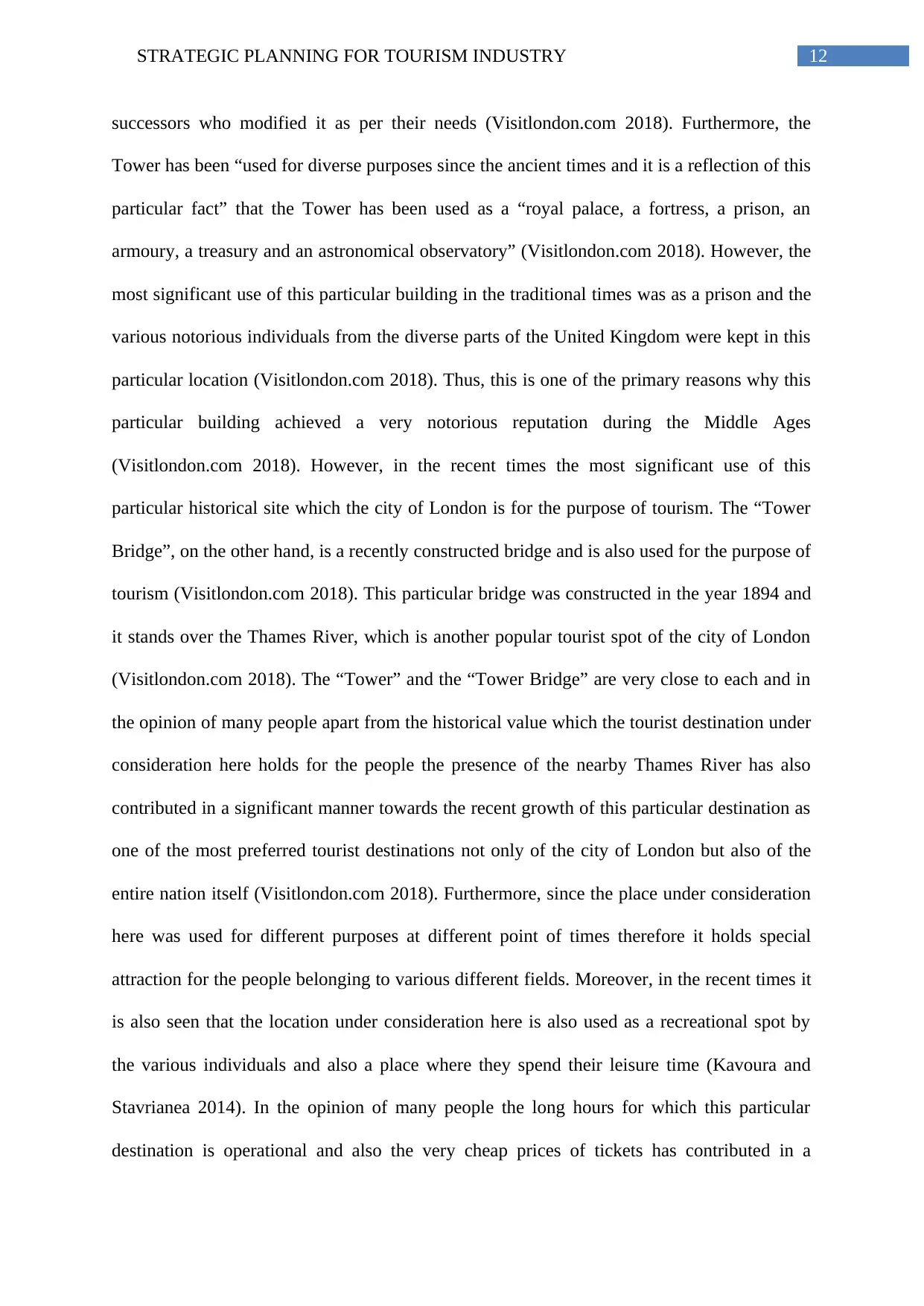
12STRATEGIC PLANNING FOR TOURISM INDUSTRY
successors who modified it as per their needs (Visitlondon.com 2018). Furthermore, the
Tower has been “used for diverse purposes since the ancient times and it is a reflection of this
particular fact” that the Tower has been used as a “royal palace, a fortress, a prison, an
armoury, a treasury and an astronomical observatory” (Visitlondon.com 2018). However, the
most significant use of this particular building in the traditional times was as a prison and the
various notorious individuals from the diverse parts of the United Kingdom were kept in this
particular location (Visitlondon.com 2018). Thus, this is one of the primary reasons why this
particular building achieved a very notorious reputation during the Middle Ages
(Visitlondon.com 2018). However, in the recent times the most significant use of this
particular historical site which the city of London is for the purpose of tourism. The “Tower
Bridge”, on the other hand, is a recently constructed bridge and is also used for the purpose of
tourism (Visitlondon.com 2018). This particular bridge was constructed in the year 1894 and
it stands over the Thames River, which is another popular tourist spot of the city of London
(Visitlondon.com 2018). The “Tower” and the “Tower Bridge” are very close to each and in
the opinion of many people apart from the historical value which the tourist destination under
consideration here holds for the people the presence of the nearby Thames River has also
contributed in a significant manner towards the recent growth of this particular destination as
one of the most preferred tourist destinations not only of the city of London but also of the
entire nation itself (Visitlondon.com 2018). Furthermore, since the place under consideration
here was used for different purposes at different point of times therefore it holds special
attraction for the people belonging to various different fields. Moreover, in the recent times it
is also seen that the location under consideration here is also used as a recreational spot by
the various individuals and also a place where they spend their leisure time (Kavoura and
Stavrianea 2014). In the opinion of many people the long hours for which this particular
destination is operational and also the very cheap prices of tickets has contributed in a
successors who modified it as per their needs (Visitlondon.com 2018). Furthermore, the
Tower has been “used for diverse purposes since the ancient times and it is a reflection of this
particular fact” that the Tower has been used as a “royal palace, a fortress, a prison, an
armoury, a treasury and an astronomical observatory” (Visitlondon.com 2018). However, the
most significant use of this particular building in the traditional times was as a prison and the
various notorious individuals from the diverse parts of the United Kingdom were kept in this
particular location (Visitlondon.com 2018). Thus, this is one of the primary reasons why this
particular building achieved a very notorious reputation during the Middle Ages
(Visitlondon.com 2018). However, in the recent times the most significant use of this
particular historical site which the city of London is for the purpose of tourism. The “Tower
Bridge”, on the other hand, is a recently constructed bridge and is also used for the purpose of
tourism (Visitlondon.com 2018). This particular bridge was constructed in the year 1894 and
it stands over the Thames River, which is another popular tourist spot of the city of London
(Visitlondon.com 2018). The “Tower” and the “Tower Bridge” are very close to each and in
the opinion of many people apart from the historical value which the tourist destination under
consideration here holds for the people the presence of the nearby Thames River has also
contributed in a significant manner towards the recent growth of this particular destination as
one of the most preferred tourist destinations not only of the city of London but also of the
entire nation itself (Visitlondon.com 2018). Furthermore, since the place under consideration
here was used for different purposes at different point of times therefore it holds special
attraction for the people belonging to various different fields. Moreover, in the recent times it
is also seen that the location under consideration here is also used as a recreational spot by
the various individuals and also a place where they spend their leisure time (Kavoura and
Stavrianea 2014). In the opinion of many people the long hours for which this particular
destination is operational and also the very cheap prices of tickets has contributed in a
Paraphrase This Document
Need a fresh take? Get an instant paraphrase of this document with our AI Paraphraser
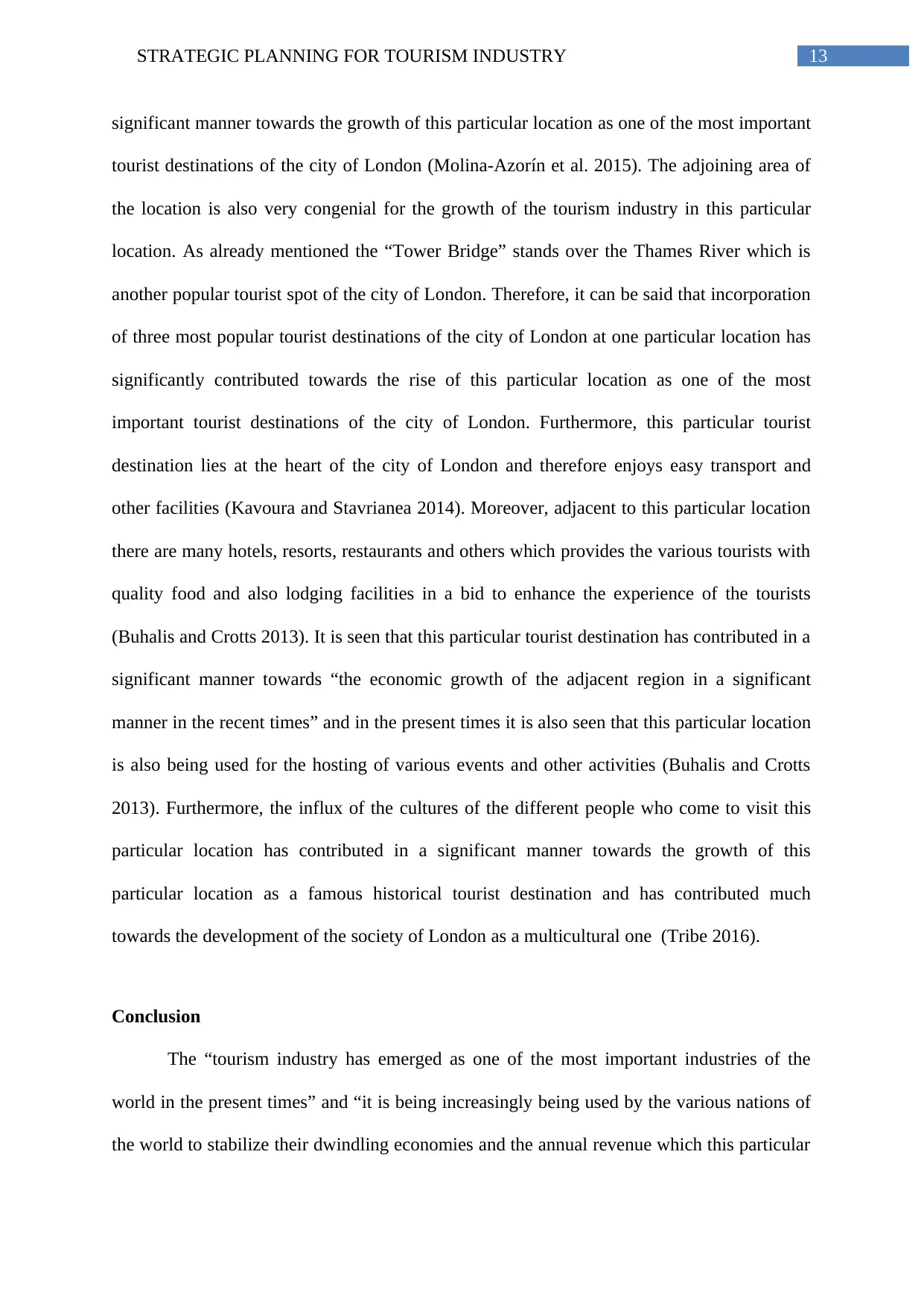
13STRATEGIC PLANNING FOR TOURISM INDUSTRY
significant manner towards the growth of this particular location as one of the most important
tourist destinations of the city of London (Molina-Azorín et al. 2015). The adjoining area of
the location is also very congenial for the growth of the tourism industry in this particular
location. As already mentioned the “Tower Bridge” stands over the Thames River which is
another popular tourist spot of the city of London. Therefore, it can be said that incorporation
of three most popular tourist destinations of the city of London at one particular location has
significantly contributed towards the rise of this particular location as one of the most
important tourist destinations of the city of London. Furthermore, this particular tourist
destination lies at the heart of the city of London and therefore enjoys easy transport and
other facilities (Kavoura and Stavrianea 2014). Moreover, adjacent to this particular location
there are many hotels, resorts, restaurants and others which provides the various tourists with
quality food and also lodging facilities in a bid to enhance the experience of the tourists
(Buhalis and Crotts 2013). It is seen that this particular tourist destination has contributed in a
significant manner towards “the economic growth of the adjacent region in a significant
manner in the recent times” and in the present times it is also seen that this particular location
is also being used for the hosting of various events and other activities (Buhalis and Crotts
2013). Furthermore, the influx of the cultures of the different people who come to visit this
particular location has contributed in a significant manner towards the growth of this
particular location as a famous historical tourist destination and has contributed much
towards the development of the society of London as a multicultural one (Tribe 2016).
Conclusion
The “tourism industry has emerged as one of the most important industries of the
world in the present times” and “it is being increasingly being used by the various nations of
the world to stabilize their dwindling economies and the annual revenue which this particular
significant manner towards the growth of this particular location as one of the most important
tourist destinations of the city of London (Molina-Azorín et al. 2015). The adjoining area of
the location is also very congenial for the growth of the tourism industry in this particular
location. As already mentioned the “Tower Bridge” stands over the Thames River which is
another popular tourist spot of the city of London. Therefore, it can be said that incorporation
of three most popular tourist destinations of the city of London at one particular location has
significantly contributed towards the rise of this particular location as one of the most
important tourist destinations of the city of London. Furthermore, this particular tourist
destination lies at the heart of the city of London and therefore enjoys easy transport and
other facilities (Kavoura and Stavrianea 2014). Moreover, adjacent to this particular location
there are many hotels, resorts, restaurants and others which provides the various tourists with
quality food and also lodging facilities in a bid to enhance the experience of the tourists
(Buhalis and Crotts 2013). It is seen that this particular tourist destination has contributed in a
significant manner towards “the economic growth of the adjacent region in a significant
manner in the recent times” and in the present times it is also seen that this particular location
is also being used for the hosting of various events and other activities (Buhalis and Crotts
2013). Furthermore, the influx of the cultures of the different people who come to visit this
particular location has contributed in a significant manner towards the growth of this
particular location as a famous historical tourist destination and has contributed much
towards the development of the society of London as a multicultural one (Tribe 2016).
Conclusion
The “tourism industry has emerged as one of the most important industries of the
world in the present times” and “it is being increasingly being used by the various nations of
the world to stabilize their dwindling economies and the annual revenue which this particular
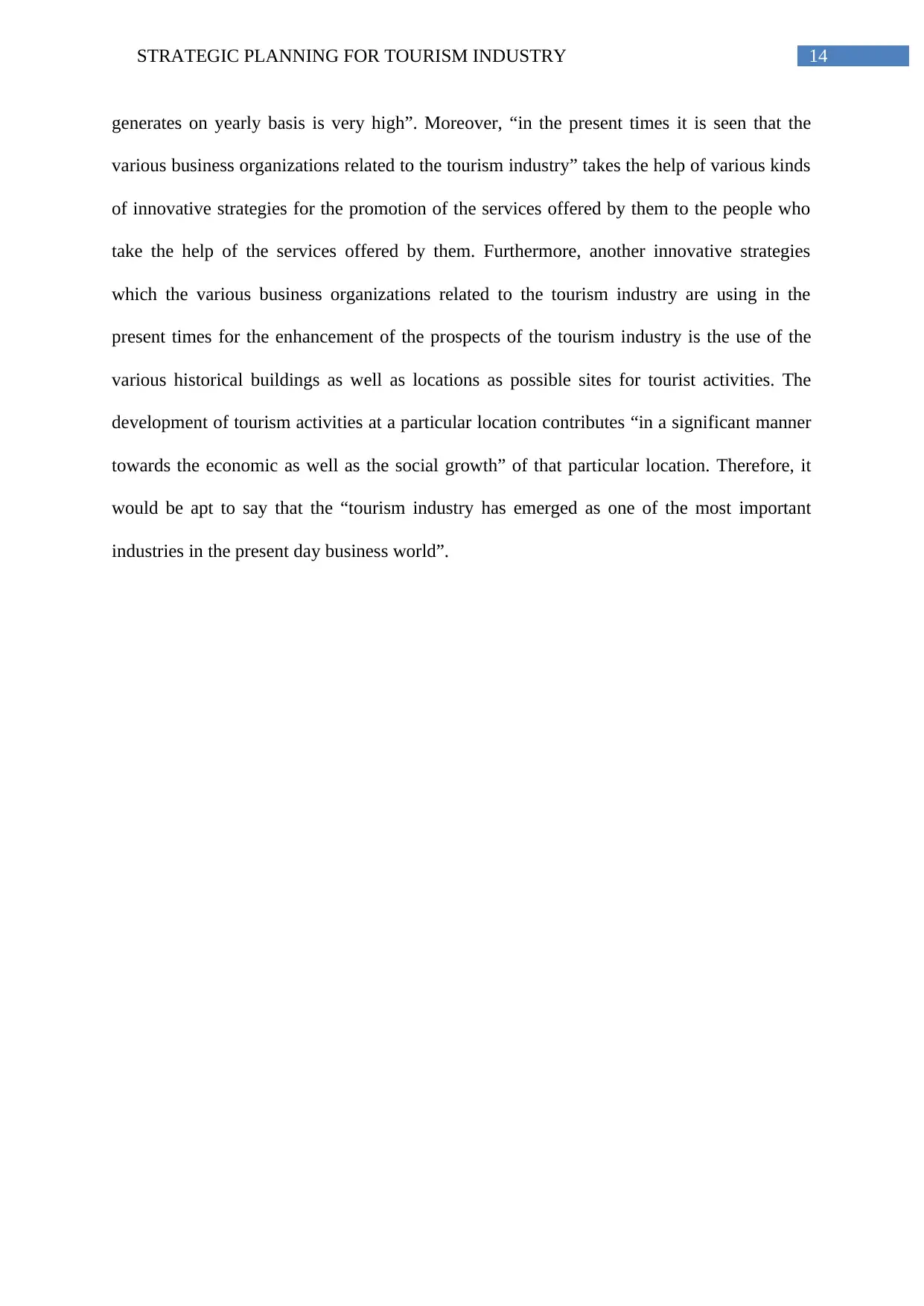
14STRATEGIC PLANNING FOR TOURISM INDUSTRY
generates on yearly basis is very high”. Moreover, “in the present times it is seen that the
various business organizations related to the tourism industry” takes the help of various kinds
of innovative strategies for the promotion of the services offered by them to the people who
take the help of the services offered by them. Furthermore, another innovative strategies
which the various business organizations related to the tourism industry are using in the
present times for the enhancement of the prospects of the tourism industry is the use of the
various historical buildings as well as locations as possible sites for tourist activities. The
development of tourism activities at a particular location contributes “in a significant manner
towards the economic as well as the social growth” of that particular location. Therefore, it
would be apt to say that the “tourism industry has emerged as one of the most important
industries in the present day business world”.
generates on yearly basis is very high”. Moreover, “in the present times it is seen that the
various business organizations related to the tourism industry” takes the help of various kinds
of innovative strategies for the promotion of the services offered by them to the people who
take the help of the services offered by them. Furthermore, another innovative strategies
which the various business organizations related to the tourism industry are using in the
present times for the enhancement of the prospects of the tourism industry is the use of the
various historical buildings as well as locations as possible sites for tourist activities. The
development of tourism activities at a particular location contributes “in a significant manner
towards the economic as well as the social growth” of that particular location. Therefore, it
would be apt to say that the “tourism industry has emerged as one of the most important
industries in the present day business world”.
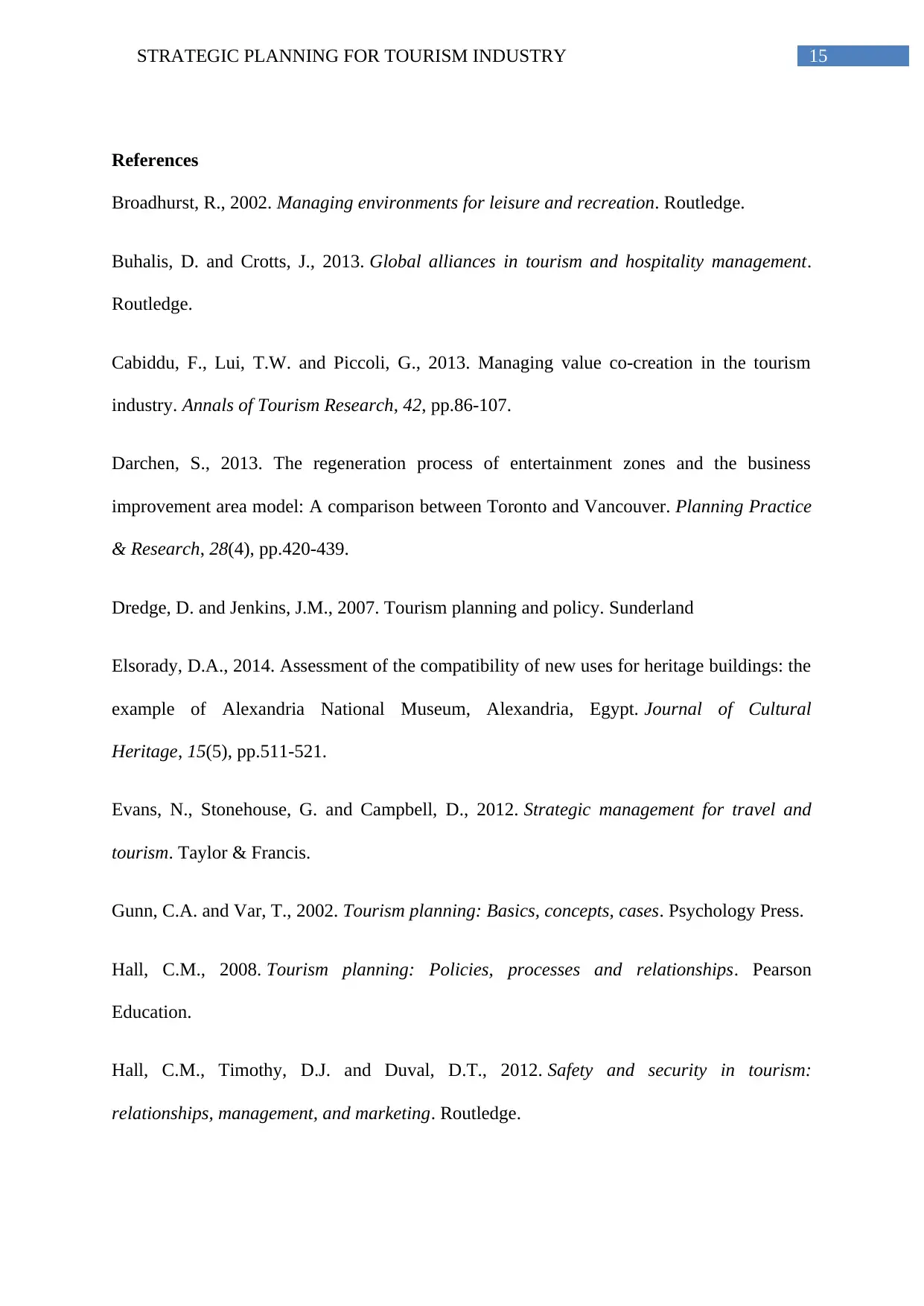
15STRATEGIC PLANNING FOR TOURISM INDUSTRY
References
Broadhurst, R., 2002. Managing environments for leisure and recreation. Routledge.
Buhalis, D. and Crotts, J., 2013. Global alliances in tourism and hospitality management.
Routledge.
Cabiddu, F., Lui, T.W. and Piccoli, G., 2013. Managing value co-creation in the tourism
industry. Annals of Tourism Research, 42, pp.86-107.
Darchen, S., 2013. The regeneration process of entertainment zones and the business
improvement area model: A comparison between Toronto and Vancouver. Planning Practice
& Research, 28(4), pp.420-439.
Dredge, D. and Jenkins, J.M., 2007. Tourism planning and policy. Sunderland
Elsorady, D.A., 2014. Assessment of the compatibility of new uses for heritage buildings: the
example of Alexandria National Museum, Alexandria, Egypt. Journal of Cultural
Heritage, 15(5), pp.511-521.
Evans, N., Stonehouse, G. and Campbell, D., 2012. Strategic management for travel and
tourism. Taylor & Francis.
Gunn, C.A. and Var, T., 2002. Tourism planning: Basics, concepts, cases. Psychology Press.
Hall, C.M., 2008. Tourism planning: Policies, processes and relationships. Pearson
Education.
Hall, C.M., Timothy, D.J. and Duval, D.T., 2012. Safety and security in tourism:
relationships, management, and marketing. Routledge.
References
Broadhurst, R., 2002. Managing environments for leisure and recreation. Routledge.
Buhalis, D. and Crotts, J., 2013. Global alliances in tourism and hospitality management.
Routledge.
Cabiddu, F., Lui, T.W. and Piccoli, G., 2013. Managing value co-creation in the tourism
industry. Annals of Tourism Research, 42, pp.86-107.
Darchen, S., 2013. The regeneration process of entertainment zones and the business
improvement area model: A comparison between Toronto and Vancouver. Planning Practice
& Research, 28(4), pp.420-439.
Dredge, D. and Jenkins, J.M., 2007. Tourism planning and policy. Sunderland
Elsorady, D.A., 2014. Assessment of the compatibility of new uses for heritage buildings: the
example of Alexandria National Museum, Alexandria, Egypt. Journal of Cultural
Heritage, 15(5), pp.511-521.
Evans, N., Stonehouse, G. and Campbell, D., 2012. Strategic management for travel and
tourism. Taylor & Francis.
Gunn, C.A. and Var, T., 2002. Tourism planning: Basics, concepts, cases. Psychology Press.
Hall, C.M., 2008. Tourism planning: Policies, processes and relationships. Pearson
Education.
Hall, C.M., Timothy, D.J. and Duval, D.T., 2012. Safety and security in tourism:
relationships, management, and marketing. Routledge.
Secure Best Marks with AI Grader
Need help grading? Try our AI Grader for instant feedback on your assignments.
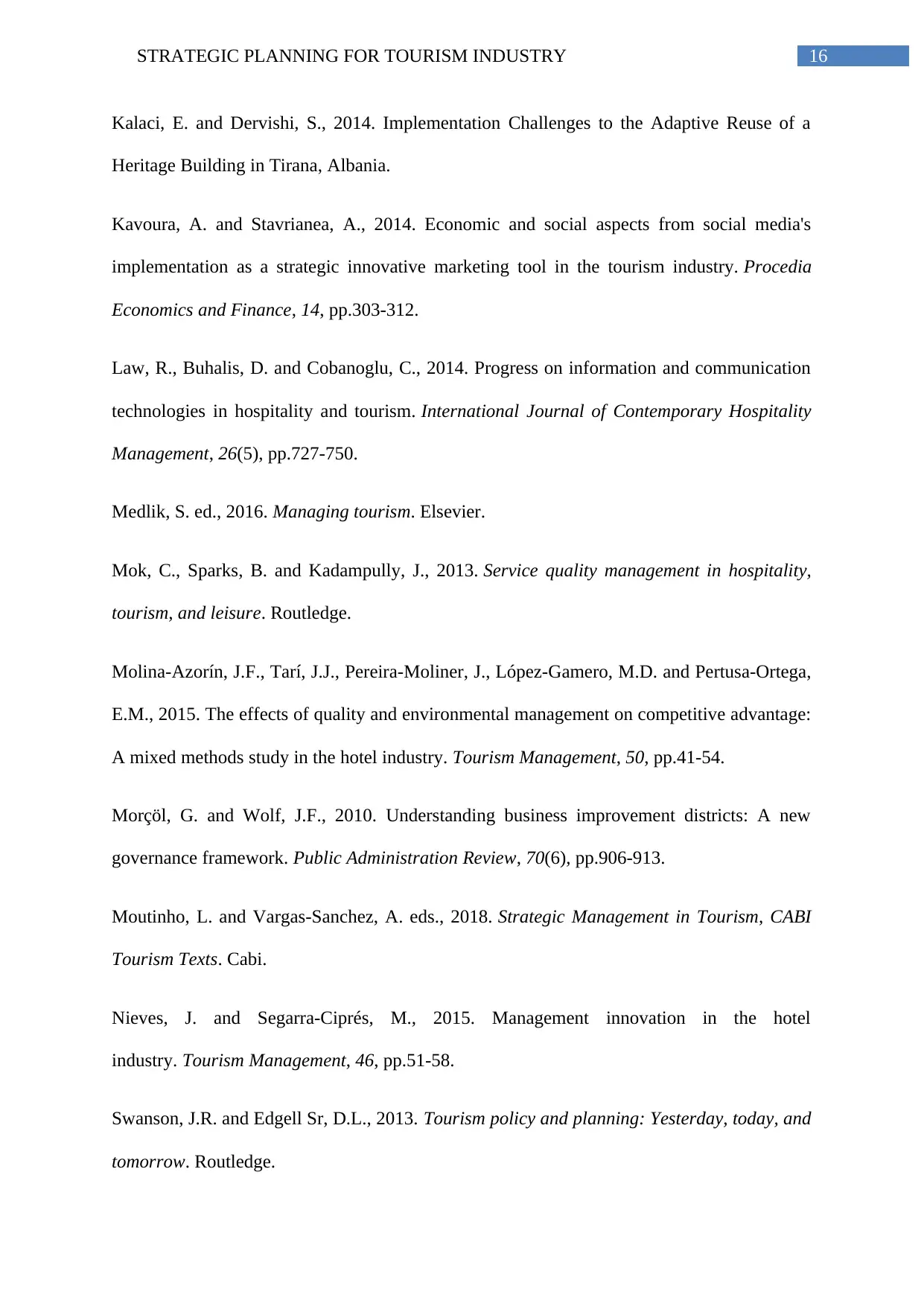
16STRATEGIC PLANNING FOR TOURISM INDUSTRY
Kalaci, E. and Dervishi, S., 2014. Implementation Challenges to the Adaptive Reuse of a
Heritage Building in Tirana, Albania.
Kavoura, A. and Stavrianea, A., 2014. Economic and social aspects from social media's
implementation as a strategic innovative marketing tool in the tourism industry. Procedia
Economics and Finance, 14, pp.303-312.
Law, R., Buhalis, D. and Cobanoglu, C., 2014. Progress on information and communication
technologies in hospitality and tourism. International Journal of Contemporary Hospitality
Management, 26(5), pp.727-750.
Medlik, S. ed., 2016. Managing tourism. Elsevier.
Mok, C., Sparks, B. and Kadampully, J., 2013. Service quality management in hospitality,
tourism, and leisure. Routledge.
Molina-Azorín, J.F., Tarí, J.J., Pereira-Moliner, J., López-Gamero, M.D. and Pertusa-Ortega,
E.M., 2015. The effects of quality and environmental management on competitive advantage:
A mixed methods study in the hotel industry. Tourism Management, 50, pp.41-54.
Morçöl, G. and Wolf, J.F., 2010. Understanding business improvement districts: A new
governance framework. Public Administration Review, 70(6), pp.906-913.
Moutinho, L. and Vargas-Sanchez, A. eds., 2018. Strategic Management in Tourism, CABI
Tourism Texts. Cabi.
Nieves, J. and Segarra-Ciprés, M., 2015. Management innovation in the hotel
industry. Tourism Management, 46, pp.51-58.
Swanson, J.R. and Edgell Sr, D.L., 2013. Tourism policy and planning: Yesterday, today, and
tomorrow. Routledge.
Kalaci, E. and Dervishi, S., 2014. Implementation Challenges to the Adaptive Reuse of a
Heritage Building in Tirana, Albania.
Kavoura, A. and Stavrianea, A., 2014. Economic and social aspects from social media's
implementation as a strategic innovative marketing tool in the tourism industry. Procedia
Economics and Finance, 14, pp.303-312.
Law, R., Buhalis, D. and Cobanoglu, C., 2014. Progress on information and communication
technologies in hospitality and tourism. International Journal of Contemporary Hospitality
Management, 26(5), pp.727-750.
Medlik, S. ed., 2016. Managing tourism. Elsevier.
Mok, C., Sparks, B. and Kadampully, J., 2013. Service quality management in hospitality,
tourism, and leisure. Routledge.
Molina-Azorín, J.F., Tarí, J.J., Pereira-Moliner, J., López-Gamero, M.D. and Pertusa-Ortega,
E.M., 2015. The effects of quality and environmental management on competitive advantage:
A mixed methods study in the hotel industry. Tourism Management, 50, pp.41-54.
Morçöl, G. and Wolf, J.F., 2010. Understanding business improvement districts: A new
governance framework. Public Administration Review, 70(6), pp.906-913.
Moutinho, L. and Vargas-Sanchez, A. eds., 2018. Strategic Management in Tourism, CABI
Tourism Texts. Cabi.
Nieves, J. and Segarra-Ciprés, M., 2015. Management innovation in the hotel
industry. Tourism Management, 46, pp.51-58.
Swanson, J.R. and Edgell Sr, D.L., 2013. Tourism policy and planning: Yesterday, today, and
tomorrow. Routledge.
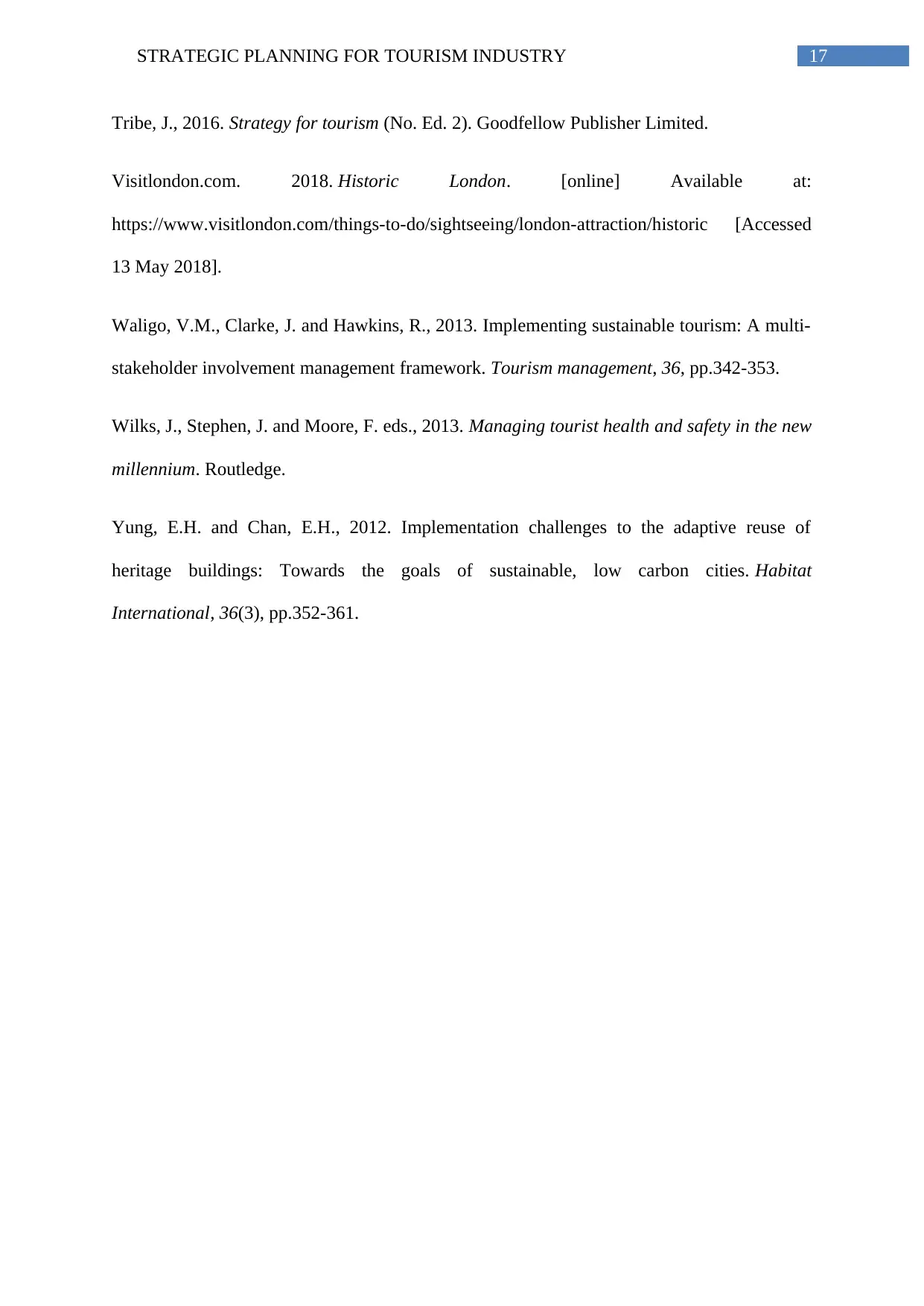
17STRATEGIC PLANNING FOR TOURISM INDUSTRY
Tribe, J., 2016. Strategy for tourism (No. Ed. 2). Goodfellow Publisher Limited.
Visitlondon.com. 2018. Historic London. [online] Available at:
https://www.visitlondon.com/things-to-do/sightseeing/london-attraction/historic [Accessed
13 May 2018].
Waligo, V.M., Clarke, J. and Hawkins, R., 2013. Implementing sustainable tourism: A multi-
stakeholder involvement management framework. Tourism management, 36, pp.342-353.
Wilks, J., Stephen, J. and Moore, F. eds., 2013. Managing tourist health and safety in the new
millennium. Routledge.
Yung, E.H. and Chan, E.H., 2012. Implementation challenges to the adaptive reuse of
heritage buildings: Towards the goals of sustainable, low carbon cities. Habitat
International, 36(3), pp.352-361.
Tribe, J., 2016. Strategy for tourism (No. Ed. 2). Goodfellow Publisher Limited.
Visitlondon.com. 2018. Historic London. [online] Available at:
https://www.visitlondon.com/things-to-do/sightseeing/london-attraction/historic [Accessed
13 May 2018].
Waligo, V.M., Clarke, J. and Hawkins, R., 2013. Implementing sustainable tourism: A multi-
stakeholder involvement management framework. Tourism management, 36, pp.342-353.
Wilks, J., Stephen, J. and Moore, F. eds., 2013. Managing tourist health and safety in the new
millennium. Routledge.
Yung, E.H. and Chan, E.H., 2012. Implementation challenges to the adaptive reuse of
heritage buildings: Towards the goals of sustainable, low carbon cities. Habitat
International, 36(3), pp.352-361.
1 out of 18
Related Documents
Your All-in-One AI-Powered Toolkit for Academic Success.
+13062052269
info@desklib.com
Available 24*7 on WhatsApp / Email
![[object Object]](/_next/static/media/star-bottom.7253800d.svg)
Unlock your academic potential
© 2024 | Zucol Services PVT LTD | All rights reserved.





